HISTORY OF THE SOVIET CALCULATORS
This article is devoted to the irreplaceable assistants in our life -
electronic calculators. The history of originating of the Soviet calculators, their
features and interesting possibilities of separate models is described.
The first calculators
 The first mechanical fitting in Russia for automation of accounts
were abacuses. This "the national calculator" has held on workstations of the
cashiers in shops down to middle of the ninetieth years. It is interesting to mark, that
in the textbook "Trade calculations" (1986) the whole chapter is devoted to
methods of calculation on the abacuses. Abacuses represent the wooden basis, on which the
metal rods are hardened, on which the wooden beads are strung. On each rod ten beads are,
except for a separator of roubles and copecks, on which four beads are. Before the
beginning of calculations all beads are moved on the right side, as shown in a figure.
Input of number start from the most significant digits of roubles, removing necessary
quantity of beads by the right hand. Abacuses are intended for addition and subtraction,
and at the defined skill the speed of execution of calculations can exceed speed of
execution of the same calculations, but with usage of the calculator. Simultaneously with
abacuses, in scientific circles, still with pre-revolutionary (before 1917) times, with
success used slide rules, which with XVII of century practically without changes worked
down to appearance of calculators. The collecting of slide rules - too very fascinating
hobby, to which can be devoted separate article. Trying how to automize the process of
calculations, the mankind starts to devise mechanical counting devices. Even known Russian
mathematician the Chebyshev in the end XIX of century has offered the model of the
calculator.
The first mechanical fitting in Russia for automation of accounts
were abacuses. This "the national calculator" has held on workstations of the
cashiers in shops down to middle of the ninetieth years. It is interesting to mark, that
in the textbook "Trade calculations" (1986) the whole chapter is devoted to
methods of calculation on the abacuses. Abacuses represent the wooden basis, on which the
metal rods are hardened, on which the wooden beads are strung. On each rod ten beads are,
except for a separator of roubles and copecks, on which four beads are. Before the
beginning of calculations all beads are moved on the right side, as shown in a figure.
Input of number start from the most significant digits of roubles, removing necessary
quantity of beads by the right hand. Abacuses are intended for addition and subtraction,
and at the defined skill the speed of execution of calculations can exceed speed of
execution of the same calculations, but with usage of the calculator. Simultaneously with
abacuses, in scientific circles, still with pre-revolutionary (before 1917) times, with
success used slide rules, which with XVII of century practically without changes worked
down to appearance of calculators. The collecting of slide rules - too very fascinating
hobby, to which can be devoted separate article. Trying how to automize the process of
calculations, the mankind starts to devise mechanical counting devices. Even known Russian
mathematician the Chebyshev in the end XIX of century has offered the model of the
calculator.
 The most popular mechanical calculator in the Soviet
times was the adding machine of the system Odhner "Felix". At the left - map of
an adding machine taken from the "Small Soviet encyclopedia" of 1932. On this
adding machine it was possible to manufacture four arithmetic operations - addition,
subtraction, multiplying and division. In later models, for example, "Felix-М",
it is possible to see toddlers for the indicating of a rule of a comma and more convenient
crandle for shift of the carriage. For production of calculations it was necessary to turn
a pen - once for addition or subtraction, and some times for multiplying and division.
The most popular mechanical calculator in the Soviet
times was the adding machine of the system Odhner "Felix". At the left - map of
an adding machine taken from the "Small Soviet encyclopedia" of 1932. On this
adding machine it was possible to manufacture four arithmetic operations - addition,
subtraction, multiplying and division. In later models, for example, "Felix-М",
it is possible to see toddlers for the indicating of a rule of a comma and more convenient
crandle for shift of the carriage. For production of calculations it was necessary to turn
a pen - once for addition or subtraction, and some times for multiplying and division.
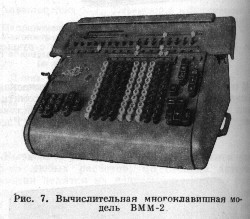 Once, certainly to twist a pen it is possible, and even it is
interesting, but what to do, if you work the bookkeeper, and for day it is necessary to
perform hundreds simple operations? And the noise from twisting counters stands decent,
especially, if simultaneously in a location with adding machines some man works. However,
in due course to twist a pen has bothered, and the human mind(wit) has struck out
electrical accounting machines, which arithmetic operations manufactured automatically or
is semi-automatic. On the right - map of the multikeyboard computer, popular per 50 years,
VMM-2 ("Goods dictionary", VIII volume, 1960). This model had nine bits and
worked up to 17 order. It had overall dimensions 440x330x240 mm and mass in 23 kgs.
Once, certainly to twist a pen it is possible, and even it is
interesting, but what to do, if you work the bookkeeper, and for day it is necessary to
perform hundreds simple operations? And the noise from twisting counters stands decent,
especially, if simultaneously in a location with adding machines some man works. However,
in due course to twist a pen has bothered, and the human mind(wit) has struck out
electrical accounting machines, which arithmetic operations manufactured automatically or
is semi-automatic. On the right - map of the multikeyboard computer, popular per 50 years,
VMM-2 ("Goods dictionary", VIII volume, 1960). This model had nine bits and
worked up to 17 order. It had overall dimensions 440x330x240 mm and mass in 23 kgs.
Per 40 years of a beginning strongly to explicate Elektronika and the first computers -
electronic - computer have appeared. To the beginning 60 years between computers and most
power counting-keyboard calculators the huge breaking was derivated on many parameters.
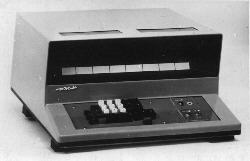 In 1961 at an exhibition of industrial reachings in England first
was demonstrated the world's first electronic calculator Anita MK-8 (England). On ending
an exhibition it is accepted decision to create domestic, completely electronic
calculator. Since 1961 a group of the scientific employees of the "Leningrad
separation of Central economic-mathematical institute of an Academy of sciences USSR"
are V. Marakhovsky, E. Kanevsky, G. Menderskaya, have begun to develop the first Soviet
electronic calculator, which has received a name "Vega". In November, 1962 the
calculator has works. On trials of a State commission were represented three created
simultaneously calculators under names "Vega", "Lada" and
"Vyatka-E". On the carried out(spent) trials has won "Vega", which was
decided to manufacture. On the created calculator by group of the developers the copyright
Certificate with priority on May 9, 1963 was obtained. To manufacture the calculator began
a Kursk Factory of accounting Machines (Schetmasch), which has placed on front The panel
of the calculator the emblem K3CM (cyrillic symbols). The electronic keyboard computing
machine (EKVM) "Vega" was serially released since 1964 and is intended for mass
usage at nonproduction accounts.
In 1961 at an exhibition of industrial reachings in England first
was demonstrated the world's first electronic calculator Anita MK-8 (England). On ending
an exhibition it is accepted decision to create domestic, completely electronic
calculator. Since 1961 a group of the scientific employees of the "Leningrad
separation of Central economic-mathematical institute of an Academy of sciences USSR"
are V. Marakhovsky, E. Kanevsky, G. Menderskaya, have begun to develop the first Soviet
electronic calculator, which has received a name "Vega". In November, 1962 the
calculator has works. On trials of a State commission were represented three created
simultaneously calculators under names "Vega", "Lada" and
"Vyatka-E". On the carried out(spent) trials has won "Vega", which was
decided to manufacture. On the created calculator by group of the developers the copyright
Certificate with priority on May 9, 1963 was obtained. To manufacture the calculator began
a Kursk Factory of accounting Machines (Schetmasch), which has placed on front The panel
of the calculator the emblem K3CM (cyrillic symbols). The electronic keyboard computing
machine (EKVM) "Vega" was serially released since 1964 and is intended for mass
usage at nonproduction accounts.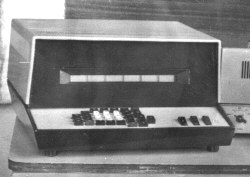 The
calculator fulfils four arithmetic operations, division of integers, translation of
fraction, exponentiation, multiplying on a constant factor and rootsquaring (!). In
the calculator was used about 1500 transistor-magnetic units.
The
calculator fulfils four arithmetic operations, division of integers, translation of
fraction, exponentiation, multiplying on a constant factor and rootsquaring (!). In
the calculator was used about 1500 transistor-magnetic units.
In 1967 by this gruop of the developers was developed the calculator EDVM (electronic
ten-keyboard computing machine) - first in our country calculator, automatically
calculating the trigonometrical function. This calculator was designed and was released
for the military topographers and was not accessible to a mass customer.
The first designed calculators had own unique titles - "Vega" (1963), EDVM
(1967), "Elektronika 68 (DD)" (1968), "Rasa" (1969), "Orbita"
(1969), "Ros" (1970).
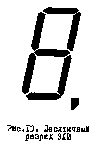
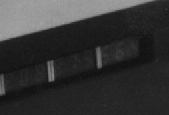 To the beginning of production of calculators,
in USSR be not struck out yet neither nixie tube displays, nor fluorescent. For the
calculator "Vega" the electroluminescent (fluorescent) display with personal
segments for displaying one digit was specially developed. Probably, this is first in a
world usage of a seven-segment display intended for for the displaying one digit. In
western calculator Friden 130 (1963) the similar display was used, but it had not the
unique seven-segment display for displaying one digit.
To the beginning of production of calculators,
in USSR be not struck out yet neither nixie tube displays, nor fluorescent. For the
calculator "Vega" the electroluminescent (fluorescent) display with personal
segments for displaying one digit was specially developed. Probably, this is first in a
world usage of a seven-segment display intended for for the displaying one digit. In
western calculator Friden 130 (1963) the similar display was used, but it had not the
unique seven-segment display for displaying one digit.
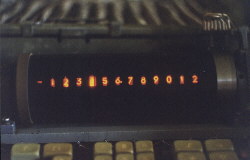 In the calculator "Rasa", which name is
written by a Latinic symbols, the unique stroboscopic display was applied. The essence of
the display was represented by(with) a drum which is resulted in driving by the motor,
spinned with frequency 1300 turnovers one minute (see fig.). Inside the calculator the
thyratrons are placed which flare during 100 us for ignition of the defined sign. In the
same calculator the Reverse Polish Notation (RPN) for execution of calculations was
applied. It means, that two numbers at first are entered, but only then the key with
required operation is pushed.
In the calculator "Rasa", which name is
written by a Latinic symbols, the unique stroboscopic display was applied. The essence of
the display was represented by(with) a drum which is resulted in driving by the motor,
spinned with frequency 1300 turnovers one minute (see fig.). Inside the calculator the
thyratrons are placed which flare during 100 us for ignition of the defined sign. In the
same calculator the Reverse Polish Notation (RPN) for execution of calculations was
applied. It means, that two numbers at first are entered, but only then the key with
required operation is pushed.
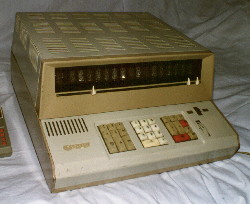
 At the end of 60 years a series of the first calculators with name
"Iskra" (Spark) set is developed. It - calculators a Iskra 11 (1969), Iskra 12
(1969) and Iskra 22 (1969). In these calculators used nixie tube display and first
microassemblies (see fig.) of units under a title "MIR-10" ("Mir" mean
two equal means "World" or "Peace" in Russian) were already applied.
At the end of 60 years a series of the first calculators with name
"Iskra" (Spark) set is developed. It - calculators a Iskra 11 (1969), Iskra 12
(1969) and Iskra 22 (1969). In these calculators used nixie tube display and first
microassemblies (see fig.) of units under a title "MIR-10" ("Mir" mean
two equal means "World" or "Peace" in Russian) were already applied.
In 1971 the first calculator operating an integrated circuits - the calculator a Iskra
110 was developed. This calculator began the large series of calculators a Iskra 100-x.
The calculators Iskra 110-114 intended for business application (countable workers,
accounts department and other), and calculators a Iskra 121-125 - for scientific
application.
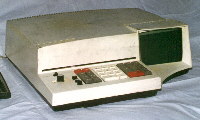
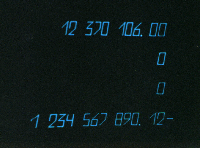 Iskra 1122 still is necessary
to pay attention to the extremely interesting calculator. This calculator was made on the
basis of the calculator a Iskra 112, but used the CRT-display is applied on the
basis of the cathode-ray tube. Simultaneously on the display contents of the operating
register and registers of memory are displayed. At mapping thousand are separated from
each other by blank, that is very convenient for perception. By the way, this calculator
was one of the most expensive released calculators with the price in 4,100 roubles
(cheapest automobile in those times had cost 3,600 roubles).
Iskra 1122 still is necessary
to pay attention to the extremely interesting calculator. This calculator was made on the
basis of the calculator a Iskra 112, but used the CRT-display is applied on the
basis of the cathode-ray tube. Simultaneously on the display contents of the operating
register and registers of memory are displayed. At mapping thousand are separated from
each other by blank, that is very convenient for perception. By the way, this calculator
was one of the most expensive released calculators with the price in 4,100 roubles
(cheapest automobile in those times had cost 3,600 roubles).
The first Soviet pocket calculator
The first Soviet desktop calculators, which have appeared in 1971, fast have won
popularity. EKVM on a basis a LSI circuit worked silently, consumed not enough energies,
evaluated fast and errorfree. The cost price of chips was fast reduced, and it was
possible to think of creation of the calculator of a pocket size, which price would be
accessible to a wide customer.
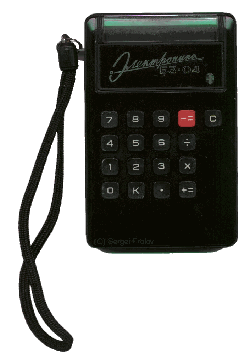 In August, 1973 the electronic industry of our country has put
the task for one year to create the electronic pocket calculator on a microprocessor LSI
circuit and with the liquid crystal indicator. Above this very complex(difficult) task
worked group of 27 men. The huge operation was coming: to make the drawings, circuit
and templates consisting from 144 thousand of points to place the microprocessor with 3400
units in a chip by a size 5х5 mm. In five months of operation the first samples of the
calculator were ready, and in nine months, three months prior to a target date, the
electronic pocket calculator under a title « Elektronika B3-04 » was handed over to a
state commission. Already in the beginning of 1974 the electronic gnome has arrived in
sale. It was the large labour victory which has shown possibilities of our electronic
industry.
In August, 1973 the electronic industry of our country has put
the task for one year to create the electronic pocket calculator on a microprocessor LSI
circuit and with the liquid crystal indicator. Above this very complex(difficult) task
worked group of 27 men. The huge operation was coming: to make the drawings, circuit
and templates consisting from 144 thousand of points to place the microprocessor with 3400
units in a chip by a size 5х5 mm. In five months of operation the first samples of the
calculator were ready, and in nine months, three months prior to a target date, the
electronic pocket calculator under a title « Elektronika B3-04 » was handed over to a
state commission. Already in the beginning of 1974 the electronic gnome has arrived in
sale. It was the large labour victory which has shown possibilities of our electronic
industry.
**** I AM ENDED TO CORRECT TRANSLATION HERE ****
The time of dream comes nearer :)))
 In
this microcalculator a liquid crystal display for the first time was applied, and the
digits were represented by white signs on a black background (see fig.). The inclusion of
the calculator was manufactured by pressing a curtain, then the cover opened, and the
calculator started operation. The microcalculator had very interesting algorithm of
operation. To calculate (20-8+7) it was necessary to push keys | C | 20 | + = | 8 | - = |
7 | + = |. Result: 5. If the result should be multiplied,say, on three, the calculations
can be continued by pressing the keys: | X | 3 | + = |. The key | K | was used for
calculation with a constant.
In
this microcalculator a liquid crystal display for the first time was applied, and the
digits were represented by white signs on a black background (see fig.). The inclusion of
the calculator was manufactured by pressing a curtain, then the cover opened, and the
calculator started operation. The microcalculator had very interesting algorithm of
operation. To calculate (20-8+7) it was necessary to push keys | C | 20 | + = | 8 | - = |
7 | + = |. Result: 5. If the result should be multiplied,say, on three, the calculations
can be continued by pressing the keys: | X | 3 | + = |. The key | K | was used for
calculation with a constant.
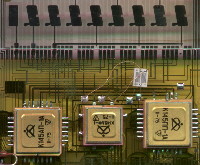
 In this
calculator the transparent cards with a space-wired interconnection were used. In a figure
the part of card of the microcalculator is shown. The microcalculator contains four chips
- 23 bit shift registers К145АP1, control unit by the indicator К145PP1, operational
register К145ИP2 and microprocessor К145ИP1. In the block of conversion of power the
chip of conversion of levels is used. It is interesting to mark, that this calculator
worked from one battery such as AA (А316 "Quantum", "Uranium").
In this
calculator the transparent cards with a space-wired interconnection were used. In a figure
the part of card of the microcalculator is shown. The microcalculator contains four chips
- 23 bit shift registers К145АP1, control unit by the indicator К145PP1, operational
register К145ИP2 and microprocessor К145ИP1. In the block of conversion of power the
chip of conversion of levels is used. It is interesting to mark, that this calculator
worked from one battery such as AA (А316 "Quantum", "Uranium").
The firsts Soviet calculators
In the beginning 70 years habitual today language of operation with microcalculators
only arose. The first models of microcalculators in general could have the language of
operation, and on the calculator it was necessary to study to consider(count). Let's take,
for example, first calculator of the Leningrad factory "Svetlana" of a series
"С". It - calculator C3-07. By the way, it is necessary to mark, that the
calculators of a factory "Svetlana" in general cost(stand) independently. Small
retreat. All microcalculators in those times have received the common denotation
"B3" (digit three on the end, instead of "З" character, as many
considered(counted)). The desktop electronic hours have received characters B2, handheld
electronic - B5 (for example, B5-207), desktop electronic with the vacuum indicator - B6,
large wall - B7, and so on. The character "@" - "home appliances".
Only microcalculators, designed Светлановским by a factory, have received the
character "With" - Svetlana (LIGHT of a BULB of an INCANDESCENCE - for those who
does not know).
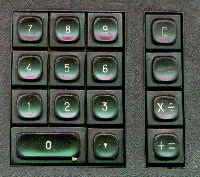 So, we shall take, for example, calculator C3-07. The very
surprising calculator, especially, his(its) keyboard and display. As it is visible from a
picture, on the calculator are combined not only key | + = | and | - = |, but also to
multiply - divide | X -:- |. Try to guess, as on this calculator to multiply and to
divide. The hint: the calculator does not perceive two pressing one key, one is possible
only.
So, we shall take, for example, calculator C3-07. The very
surprising calculator, especially, his(its) keyboard and display. As it is visible from a
picture, on the calculator are combined not only key | + = | and | - = |, but also to
multiply - divide | X -:- |. Try to guess, as on this calculator to multiply and to
divide. The hint: the calculator does not perceive two pressing one key, one is possible
only.
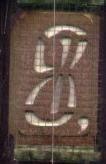 The answer is not less surprising: to manufacture,say, multiplying 2 on 3, it
is necessary to push keys | 2 | X-:- | 3 | + = |, and to divide 2 on 3, it is necessary to
push keys: | 2 | X-:- | 3 | - = |. The addition and subtraction occurs similarly to
calculator B3-04, that is, the obtaining of a difference 2 - 3 will be evaluated so: | 2 |
+ = | 3 | - = |. In some models of this calculator it is possible to meet and surprising
eight-segment indicator. Since this model of calculators, all simple calculators
Светлановского of a factory operate with numbers with the orders up to
10e16-1, even if on the display is located eight or twelve bits. If the result exceeds 8
or 12 bits (depending on model), the comma fades and on the display there are first 8 or
12 bits of number. Speaking about the language of operation with microcalculators of first
printings, it is necessary to mention and calculators B3-02, B3-05 and B3-11. It - mark of
old calculators such as "Iskra" of 110 series. In these calculators at
calculations all bits of the indicator permanently shine. In main, certainly, zero&.
It is very inconvenient to retrieve on such calculators first (and last) significant bit.
By the way, in model C3-07, about which was spoken earlier, already there was an attempt
to decide(solve) this problem, though and a little bit unusual way - on this calculator
the zero has half of height. So, these three calculators had very inconvenient, but
feature, quite explained for early calculators: the required accuracy of calculations is
set at input of the first. That is, if it is necessary,say, to calculate a quotient from
division 23 on 32 to within three signs after a comma, the number 23 is necessary for
entering with three signs after a comma: | 23,000 | -:- | 32 | = | (0.718). So long as the
operator will not push the button of reset, all subsequent calculations will be
manufactured with three signs after a comma, and the comma in general does not go anywhere
more. It, by the way, also is named " as the fixed comma ", and later
calculators, in which the comma is already transferred on the display, then were named
" from a floating point ". Now, in a terminology there were changes, as a result
of which from "floating point" mappings number with a mantissa at the left and
order on the right now are named.
The answer is not less surprising: to manufacture,say, multiplying 2 on 3, it
is necessary to push keys | 2 | X-:- | 3 | + = |, and to divide 2 on 3, it is necessary to
push keys: | 2 | X-:- | 3 | - = |. The addition and subtraction occurs similarly to
calculator B3-04, that is, the obtaining of a difference 2 - 3 will be evaluated so: | 2 |
+ = | 3 | - = |. In some models of this calculator it is possible to meet and surprising
eight-segment indicator. Since this model of calculators, all simple calculators
Светлановского of a factory operate with numbers with the orders up to
10e16-1, even if on the display is located eight or twelve bits. If the result exceeds 8
or 12 bits (depending on model), the comma fades and on the display there are first 8 or
12 bits of number. Speaking about the language of operation with microcalculators of first
printings, it is necessary to mention and calculators B3-02, B3-05 and B3-11. It - mark of
old calculators such as "Iskra" of 110 series. In these calculators at
calculations all bits of the indicator permanently shine. In main, certainly, zero&.
It is very inconvenient to retrieve on such calculators first (and last) significant bit.
By the way, in model C3-07, about which was spoken earlier, already there was an attempt
to decide(solve) this problem, though and a little bit unusual way - on this calculator
the zero has half of height. So, these three calculators had very inconvenient, but
feature, quite explained for early calculators: the required accuracy of calculations is
set at input of the first. That is, if it is necessary,say, to calculate a quotient from
division 23 on 32 to within three signs after a comma, the number 23 is necessary for
entering with three signs after a comma: | 23,000 | -:- | 32 | = | (0.718). So long as the
operator will not push the button of reset, all subsequent calculations will be
manufactured with three signs after a comma, and the comma in general does not go anywhere
more. It, by the way, also is named " as the fixed comma ", and later
calculators, in which the comma is already transferred on the display, then were named
" from a floating point ". Now, in a terminology there were changes, as a result
of which from "floating point" mappings number with a mantissa at the left and
order on the right now are named.
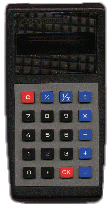 In one year after development of the first pocket microcalculator B3-04 more
perfect models pocket MK have appeared new. It - model B3-09М, B3-14 and B3-14М. These
calculators were made on one chip of the processor К145ИК2 and one chip of the
generator of phases. The calculator B3-09М at the left is shown, in the same tank is made
and B3-14М, on the right - B3-14.
In one year after development of the first pocket microcalculator B3-04 more
perfect models pocket MK have appeared new. It - model B3-09М, B3-14 and B3-14М. These
calculators were made on one chip of the processor К145ИК2 and one chip of the
generator of phases. The calculator B3-09М at the left is shown, in the same tank is made
and B3-14М, on the right - B3-14.  On these models there was already
"standard" language of operation on calculators, including calculations with a
constant. These calculators already could work both from a power supply unit, and from
four (B3-09М, B3-14М) or three (B3-14) of units such as АА. Though these calculators
are made on one about the same chip, but had different functionalities. And in general,
"уBирание" of different functions was inherent in many models of the
Soviet microcalculators. For example, the microcalculator B3-09М did not have sign of
calculation of the square root, B3-14М is not skilful to evaluate percents. Feature of
these simple calculators was that the comma borrowed(occupied) separate bit. It is very
convenient for fluent reading of the information, but thus the last sign bit disappears.
For the same calculators before the beginning of operation it is necessary to push the
"C" key for clearing the registers.
On these models there was already
"standard" language of operation on calculators, including calculations with a
constant. These calculators already could work both from a power supply unit, and from
four (B3-09М, B3-14М) or three (B3-14) of units such as АА. Though these calculators
are made on one about the same chip, but had different functionalities. And in general,
"уBирание" of different functions was inherent in many models of the
Soviet microcalculators. For example, the microcalculator B3-09М did not have sign of
calculation of the square root, B3-14М is not skilful to evaluate percents. Feature of
these simple calculators was that the comma borrowed(occupied) separate bit. It is very
convenient for fluent reading of the information, but thus the last sign bit disappears.
For the same calculators before the beginning of operation it is necessary to push the
"C" key for clearing the registers.
The first Soviet engineering calculator
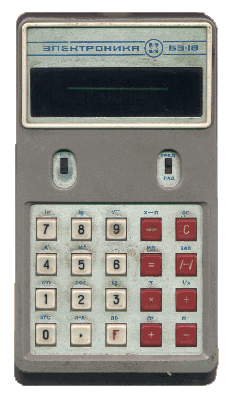 Following huge step in a history of development of calculators
became appearance of the first Soviet engineering calculator. At the end of 1975 in the
Soviet Union the first engineering calculator B3-18 was created. As wrote in this occasion
a magazine " a Science and Life " 10, 1976 in paper " a Fantastic
electronics engineering ": "... This calculator has passed a Rubicon of
arithmetics, his(its) mathematical derivation has stepped in trigonometry and algebra.
" The electronics Engineering B3-18 " knows how instantly to erect in guadrate
and to extract the square root, in two receptions(tricks) to erect in any degree in limits
of eight bits, to evaluate reciprocals, to evaluate the logarithms and antilogarithms,
trigonometrical functions... ", ".. .. When see, how the computer, which just
instantly added huge numbers, spends some seconds to fulfil any algebraic or
trigonometrical operation, involuntarily reflect on that large operation, which goes
inside a small box, before on its(her) indicator the result " will be lighted. And is
real, the huge operation was done. In a uniform chip by a size 5 х 5,2 mm were possible
to contain 45000 transistors, resistors, capacitors and explorers, that is half-hundreds
TV sets of that time have pushed in one section of an arithmetic writting-book! However,
and the price of such calculator was considerable - 220 roubles in 1978. For an example,
the engineer after termination(ending) institute in those times received 120 roubles per
one month. But the purchase cost that. Now it is not necessary to think how to not bring
down a shade slide of a slide rule, it is not necessary to care of an error, it is
possible to desert on a shelf of a table of logarithms. By the way, in this calculator the
key of the prefix "F" function for the first time was applied. Nevertheless in a
chip К145ИP7 of the calculator B3-18 it was not possible completely to contain
everything, that would be desirable. For example, at function evaluation, in which the
expansion in a series Theilor was used, the working register was cleared, therefore the
previous result of the operation was cleared. In this connection it was impossible to
manufacture the continiouses of calculation, such as 5 + sin 2. For this purpose at first
it was necessary to receive sine from two, and then only to add to result 5. So, the
operation is done large, the large efforts are spent, and as a result has appeared good,
but very dear(expensive) calculator. That the calculator was accessible to mass layers of
the population, the solution was accepted on the basis of the calculator B3-18А to make
cheaper model. To not devise a bicycle, our engineers transmit on the easiest paths. They
have taken and have removed the key of the prefix "F" function from the
calculator. The calculator has turned in usual, has received a title "B3-25А"
and became to accessible wide layers of the population. And only developers and repairmen
of calculators knew secret of alteration B3-25А.
Following huge step in a history of development of calculators
became appearance of the first Soviet engineering calculator. At the end of 1975 in the
Soviet Union the first engineering calculator B3-18 was created. As wrote in this occasion
a magazine " a Science and Life " 10, 1976 in paper " a Fantastic
electronics engineering ": "... This calculator has passed a Rubicon of
arithmetics, his(its) mathematical derivation has stepped in trigonometry and algebra.
" The electronics Engineering B3-18 " knows how instantly to erect in guadrate
and to extract the square root, in two receptions(tricks) to erect in any degree in limits
of eight bits, to evaluate reciprocals, to evaluate the logarithms and antilogarithms,
trigonometrical functions... ", ".. .. When see, how the computer, which just
instantly added huge numbers, spends some seconds to fulfil any algebraic or
trigonometrical operation, involuntarily reflect on that large operation, which goes
inside a small box, before on its(her) indicator the result " will be lighted. And is
real, the huge operation was done. In a uniform chip by a size 5 х 5,2 mm were possible
to contain 45000 transistors, resistors, capacitors and explorers, that is half-hundreds
TV sets of that time have pushed in one section of an arithmetic writting-book! However,
and the price of such calculator was considerable - 220 roubles in 1978. For an example,
the engineer after termination(ending) institute in those times received 120 roubles per
one month. But the purchase cost that. Now it is not necessary to think how to not bring
down a shade slide of a slide rule, it is not necessary to care of an error, it is
possible to desert on a shelf of a table of logarithms. By the way, in this calculator the
key of the prefix "F" function for the first time was applied. Nevertheless in a
chip К145ИP7 of the calculator B3-18 it was not possible completely to contain
everything, that would be desirable. For example, at function evaluation, in which the
expansion in a series Theilor was used, the working register was cleared, therefore the
previous result of the operation was cleared. In this connection it was impossible to
manufacture the continiouses of calculation, such as 5 + sin 2. For this purpose at first
it was necessary to receive sine from two, and then only to add to result 5. So, the
operation is done large, the large efforts are spent, and as a result has appeared good,
but very dear(expensive) calculator. That the calculator was accessible to mass layers of
the population, the solution was accepted on the basis of the calculator B3-18А to make
cheaper model. To not devise a bicycle, our engineers transmit on the easiest paths. They
have taken and have removed the key of the prefix "F" function from the
calculator. The calculator has turned in usual, has received a title "B3-25А"
and became to accessible wide layers of the population. And only developers and repairmen
of calculators knew secret of alteration B3-25А.
Further development of calculators
At once after the calculator B3-18 together with the engineers from GDR the calculator
B3-19М was released. In this calculator the return Polish notation " was used
so-called ". The first at first is typed, then the Enter key  of number in the stack, then
second, and only after that - required operation is pushed. The stack in the calculator
consists of three registers - X, Y and Z. In the same calculator input of exponent and
show of number in the format from a floating point (with a mantissa and order) for the
first time was applied. In the calculator the 12-bit indicator on red light-emitting
diodes was used.
of number in the stack, then
second, and only after that - required operation is pushed. The stack in the calculator
consists of three registers - X, Y and Z. In the same calculator input of exponent and
show of number in the format from a floating point (with a mantissa and order) for the
first time was applied. In the calculator the 12-bit indicator on red light-emitting
diodes was used.
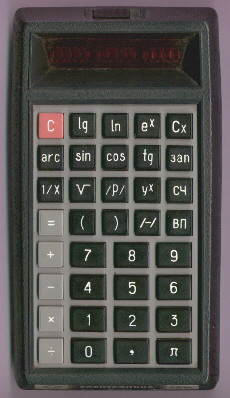 In 1976 other very power engineering calculator - C3-15 has
appeared. This calculator had heightened accuracy of calculations (up to 12 bits), worked
with the orders up to 9, (9) in 99 degrees, had three registers of memory, but most
remarkable - worked with algebraic logic. That is, to calculate under the formula 2 + 3 *
5, it was not necessary at first to evaluate 3 * 5, and then to result to add 2. This
formula could be written in "natural" sort: | 2 | + | 3 | * | 5 | = |. Besides
in the calculator the brackets up to eight levels were used. Still this calculator -
unique(sole) calculator, which together with the desktop brother MK-41 had the key /p/.
This key was used for calculations under the formula sqrt (x^2 + y^2). The calculator
C3-15 - was developed since 1974 at involvement of the Leningrad scientists. In this
calculator the algorithm "CORDIC" was applied for calculation of elementary
functions. Mathematical аPPарат was offered by the professor V. Baykov, brought in
the large contribution in development of algorithm CORDIC (http://devil.ece.utexas.edu/baykov/index.html).
In 1976 other very power engineering calculator - C3-15 has
appeared. This calculator had heightened accuracy of calculations (up to 12 bits), worked
with the orders up to 9, (9) in 99 degrees, had three registers of memory, but most
remarkable - worked with algebraic logic. That is, to calculate under the formula 2 + 3 *
5, it was not necessary at first to evaluate 3 * 5, and then to result to add 2. This
formula could be written in "natural" sort: | 2 | + | 3 | * | 5 | = |. Besides
in the calculator the brackets up to eight levels were used. Still this calculator -
unique(sole) calculator, which together with the desktop brother MK-41 had the key /p/.
This key was used for calculations under the formula sqrt (x^2 + y^2). The calculator
C3-15 - was developed since 1974 at involvement of the Leningrad scientists. In this
calculator the algorithm "CORDIC" was applied for calculation of elementary
functions. Mathematical аPPарат was offered by the professor V. Baykov, brought in
the large contribution in development of algorithm CORDIC (http://devil.ece.utexas.edu/baykov/index.html).
 In 1977 the chip К145ИP11 was developed which has caused the whole series
of calculators. Very first of them was the very known calculator B3-26 (in a figure on the
right). As with calculators B3-09М, B3-14 and B3-14М, and also B3-18А and B3-25А have
done without by an identical image - by deleting some functions. On the basis of the
calculator B3-26 the calculators B3-23 with percents, B3-23А with the square root,
B3-24Г with memory were made. By the way, the calculator B3-23А subsequently became the
cheapest Soviet calculator with the price all in 18 roubles. B3-26 soon began to be named
MK-26 and his(its) summary brother MK-57 and MK-57А with similar functions has appeared.
Светлановский the factory also has pleased with the model C3-27, which, the
truth, has not got accustomed, and she(it) soon was replaced by(with) very popular and
cheap model C3-33 and its(her) development - MK-33.
In 1977 the chip К145ИP11 was developed which has caused the whole series
of calculators. Very first of them was the very known calculator B3-26 (in a figure on the
right). As with calculators B3-09М, B3-14 and B3-14М, and also B3-18А and B3-25А have
done without by an identical image - by deleting some functions. On the basis of the
calculator B3-26 the calculators B3-23 with percents, B3-23А with the square root,
B3-24Г with memory were made. By the way, the calculator B3-23А subsequently became the
cheapest Soviet calculator with the price all in 18 roubles. B3-26 soon began to be named
MK-26 and his(its) summary brother MK-57 and MK-57А with similar functions has appeared.
Светлановский the factory also has pleased with the model C3-27, which, the
truth, has not got accustomed, and she(it) soon was replaced by(with) very popular and
cheap model C3-33 and its(her) development - MK-33.
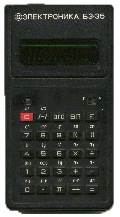 One more direction in development of calculators became engineering B3-35
(MK-35) and B3-36 (MK-36). B3-35 differed from B3-36 by more simple design and cost on
five roubles more cheaply.
One more direction in development of calculators became engineering B3-35
(MK-35) and B3-36 (MK-36). B3-35 differed from B3-36 by more simple design and cost on
five roubles more cheaply. 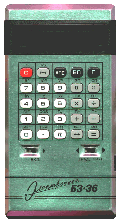 These calculators knew how to translate degrees in
radians and on the contrary, to multiply and to divide numbers in memory, and also to
evaluate factorial. Very interestingly these calculators evaluated factorial - simple
exhaustive search. On calculation of maximum value of factorial in 69 on the calculator
B3-35 there leave more than five seconds. These calculators were very popular in us,
though had, on my sight, some disadvantage: they displayed on the indicator equally so
much significant digits, how many about it is told in the instruction. Usually them five -
six for transcendental functions. On the basis of these calculators the desktop variant
MK-45 was made.
These calculators knew how to translate degrees in
radians and on the contrary, to multiply and to divide numbers in memory, and also to
evaluate factorial. Very interestingly these calculators evaluated factorial - simple
exhaustive search. On calculation of maximum value of factorial in 69 on the calculator
B3-35 there leave more than five seconds. These calculators were very popular in us,
though had, on my sight, some disadvantage: they displayed on the indicator equally so
much significant digits, how many about it is told in the instruction. Usually them five -
six for transcendental functions. On the basis of these calculators the desktop variant
MK-45 was made.
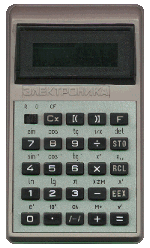 By the way, many pocket engineering calculators have the desktop brothers. It
- calculators MK-41 (C3-15), MKШ-2 (B3-32), MK-45 (B3-35, B3-36). The calculator MKШ-2 -
unique(sole) "school" calculator released by our industry, except for large
demonstration, about which will be told below. MKШ-2 this calculator feeds from the
school network 42 In., as well as the calculator B3-32 (in a figure at the left) is
skilful to evaluate the radicals of a quadratic equation and to discover the radicals of a
set of equations with two unknown. On design the calculator B3-32 is completely identical
to the calculator B3-14. Feature of the calculator except for circumscribed above - all
inscriptions on keys are fulfilled on foreign standards. For example, the key of record of
number in memory was meant not "P" and not " x- > P ", and
"STO". Call of number from memory - "RCL". Despite of possibility of
operation with numbers with the large orders, on this calculator the eight-bit display,
same as well as in B3-14 was used. It turned out, that if to map number with a mantissa
and order, on the indicator five significant digits find room only. To decide(solve) this
problem in the calculator the "CN" key is used. If, for example, result of
calculations is the number 1.2345678e-12, on the indicator it will be mapped as 1.2345-12.
Having pushed | F | CN |, we see on the indicator 12345678. The comma thus dies away.
By the way, many pocket engineering calculators have the desktop brothers. It
- calculators MK-41 (C3-15), MKШ-2 (B3-32), MK-45 (B3-35, B3-36). The calculator MKШ-2 -
unique(sole) "school" calculator released by our industry, except for large
demonstration, about which will be told below. MKШ-2 this calculator feeds from the
school network 42 In., as well as the calculator B3-32 (in a figure at the left) is
skilful to evaluate the radicals of a quadratic equation and to discover the radicals of a
set of equations with two unknown. On design the calculator B3-32 is completely identical
to the calculator B3-14. Feature of the calculator except for circumscribed above - all
inscriptions on keys are fulfilled on foreign standards. For example, the key of record of
number in memory was meant not "P" and not " x- > P ", and
"STO". Call of number from memory - "RCL". Despite of possibility of
operation with numbers with the large orders, on this calculator the eight-bit display,
same as well as in B3-14 was used. It turned out, that if to map number with a mantissa
and order, on the indicator five significant digits find room only. To decide(solve) this
problem in the calculator the "CN" key is used. If, for example, result of
calculations is the number 1.2345678e-12, on the indicator it will be mapped as 1.2345-12.
Having pushed | F | CN |, we see on the indicator 12345678. The comma thus dies away.
The first Soviet programmed calculator
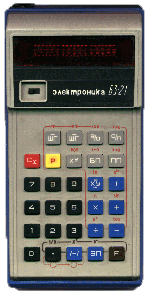 At the end of 1977 was developed, and in the beginning of 1978 the first
Soviet programmed calculator B3-21 (in a figure on the right) has acted(arrived) in sale.
It was one more large step forwards. Before the people had on many times to iterate
calculations, in calculators there was a maxima three registers of memory. Possibility
itself now has appeared to write programs and to store some numbers in memory. The term
" the programmed calculator " called(caused) Bлагоговение and some
shiver in a voice. It was the very dear(expensive) calculator - it(he) cost of the whole
350 roubles! Soon calculator was awarded is familiar qualities. The first models of
calculator B3-21 were released with the indicator on red light emitting diodes. The comma
borrowed(occupied) separate bit. Then the indicator have changed on green
катодо-luminescent, because of what it(he) began to work on 20 % more slowly. The
calculator works with return reverse Polish notation, that is at first two numbers are
entered, and then the operation is entered. After input of the first it is necessary to
push a up arrow
At the end of 1977 was developed, and in the beginning of 1978 the first
Soviet programmed calculator B3-21 (in a figure on the right) has acted(arrived) in sale.
It was one more large step forwards. Before the people had on many times to iterate
calculations, in calculators there was a maxima three registers of memory. Possibility
itself now has appeared to write programs and to store some numbers in memory. The term
" the programmed calculator " called(caused) Bлагоговение and some
shiver in a voice. It was the very dear(expensive) calculator - it(he) cost of the whole
350 roubles! Soon calculator was awarded is familiar qualities. The first models of
calculator B3-21 were released with the indicator on red light emitting diodes. The comma
borrowed(occupied) separate bit. Then the indicator have changed on green
катодо-luminescent, because of what it(he) began to work on 20 % more slowly. The
calculator works with return reverse Polish notation, that is at first two numbers are
entered, and then the operation is entered. After input of the first it is necessary to
push a up arrow  . . Except for two operational registers X and Y the calculator has the ring
stack consisting of six registers. The stack of numbers is connected to the register X.
For ring moving of numbers in the stack the special keys of moving of numbers in the stack
- clockwise and against -hour are used. Except for the ring stack in the calculator seven
registers with numbers from 2 up to 8 are stipulated. The calculator has two prefix keys -
F and P. The key F is prefix for operations designated by black colour, key P - designated
red. The prefix keys also are used for record and extract of numbers from the registers.
For record the key P, and for reading - key F is used. But I have not told about key
feature of the calculator B3-21 - ability to program! In the calculator there are 60 steps
of the program, and the addresses are written modulo six, that is the addresses go in the
following order: 00, 01, 02, 03, 04, 05, 10, 11 and so on. Each key has the opcode. The
calculator has functions of unconditional branch, transition to the subroutines, and also
transitions on a condition. The keys of branching (transitions) use two storage locations
of the calculator - one cell borrows(occupies) an opcode, and another - jump address. The
required jump address turns out, outgoing from the key code, which is pushed after
pressing the key of transition, plus 1. For example, certainly to proceed(pass) to the
address 33, it is necessary to push keys BP and 3 (code 34). The codes of operations took
from the table.
. . Except for two operational registers X and Y the calculator has the ring
stack consisting of six registers. The stack of numbers is connected to the register X.
For ring moving of numbers in the stack the special keys of moving of numbers in the stack
- clockwise and against -hour are used. Except for the ring stack in the calculator seven
registers with numbers from 2 up to 8 are stipulated. The calculator has two prefix keys -
F and P. The key F is prefix for operations designated by black colour, key P - designated
red. The prefix keys also are used for record and extract of numbers from the registers.
For record the key P, and for reading - key F is used. But I have not told about key
feature of the calculator B3-21 - ability to program! In the calculator there are 60 steps
of the program, and the addresses are written modulo six, that is the addresses go in the
following order: 00, 01, 02, 03, 04, 05, 10, 11 and so on. Each key has the opcode. The
calculator has functions of unconditional branch, transition to the subroutines, and also
transitions on a condition. The keys of branching (transitions) use two storage locations
of the calculator - one cell borrows(occupies) an opcode, and another - jump address. The
required jump address turns out, outgoing from the key code, which is pushed after
pressing the key of transition, plus 1. For example, certainly to proceed(pass) to the
address 33, it is necessary to push keys BP and 3 (code 34). The codes of operations took
from the table.
 The first programmed calculator at once became very popular in
the country. Now user could not only write complex(difficult) programs, but even to play
in games with the calculator. It was a unprecedented innovation! Beginnings to be released
the literature on a software technology on the programmed calculator. At the left in a
figure - very popular book of those times devoted to games and useful programs with usage
of the calculator B3-21.
The first programmed calculator at once became very popular in
the country. Now user could not only write complex(difficult) programs, but even to play
in games with the calculator. It was a unprecedented innovation! Beginnings to be released
the literature on a software technology on the programmed calculator. At the left in a
figure - very popular book of those times devoted to games and useful programs with usage
of the calculator B3-21.
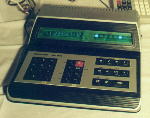 The Appearance of the
programmed calculator B3-21 has allowed even to organize production control. The desktop
variants of this calculator - MK-46 and MK-64 (figure on the right) were released. It were
the large desktop calculators having on a back part tanks special plugs. The additional
register 9 was entered, in which the code of experiment " was written, so-called
". In these calculators the data entry both from the keyboard, and from peripherals
(sensors, analog-to-digital converters and other is possible(probable).), they can realize
a control of tolerance values of entered datas and to print datas and results of their
processing through the peripheral. MK-64 differs from MK-46 by presence of the built-in
digital-to-analog converter. Many calculators MK-64 were placed(installed) in studies of
physics of special physical and mathematical schools, as they could, say, meter power from
the battery.
The Appearance of the
programmed calculator B3-21 has allowed even to organize production control. The desktop
variants of this calculator - MK-46 and MK-64 (figure on the right) were released. It were
the large desktop calculators having on a back part tanks special plugs. The additional
register 9 was entered, in which the code of experiment " was written, so-called
". In these calculators the data entry both from the keyboard, and from peripherals
(sensors, analog-to-digital converters and other is possible(probable).), they can realize
a control of tolerance values of entered datas and to print datas and results of their
processing through the peripheral. MK-64 differs from MK-46 by presence of the built-in
digital-to-analog converter. Many calculators MK-64 were placed(installed) in studies of
physics of special physical and mathematical schools, as they could, say, meter power from
the battery.
The most known calculator
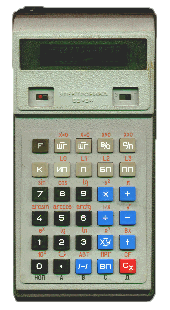 The first programmed calculators B3-21, MK-46 and MK-64, though worked on the
program, but had only two operational registers X and Y, and the operation with the ring
stack was very inconvenient. And, in 1980 on change of the calculator B3-21 the programmed
calculator B3-34 in the price 85 roubles has come. It was one more step forwards! He(it)
had stack consisting of four registers, 98 steps of program memory, 14 registers of memory
instead of seven for B3-21, and most important - possibility of organization of cycles and
operation with index registers. With the calculator began to work - one pleasure. Clones
B3-34 - MK-54, made in more beautiful design soon have appeared, and costing on 20 roubles
is cheaper at the expense of usage of power supplies of other type. Desktop variant -
MK-56 also was developed. One behind another the known popular scientific magazines began
to learn(teach) to work with the calculator. It - magazines " a Science and Life
", "Engineering - youth" and " Chemistry and Life ". In " to
a Science and Life ", since October, 1983 the special section " the Man with the
calculator " has appeared, where it was told as to work with B3-34, and also the
great many of useful and game programs was reduced. The magazine " Engineering -
Youth ", starting in 1985 at first has lead(carried out) course of programming on
B3-34 under a title " the Calculator - your assistant ",
The first programmed calculators B3-21, MK-46 and MK-64, though worked on the
program, but had only two operational registers X and Y, and the operation with the ring
stack was very inconvenient. And, in 1980 on change of the calculator B3-21 the programmed
calculator B3-34 in the price 85 roubles has come. It was one more step forwards! He(it)
had stack consisting of four registers, 98 steps of program memory, 14 registers of memory
instead of seven for B3-21, and most important - possibility of organization of cycles and
operation with index registers. With the calculator began to work - one pleasure. Clones
B3-34 - MK-54, made in more beautiful design soon have appeared, and costing on 20 roubles
is cheaper at the expense of usage of power supplies of other type. Desktop variant -
MK-56 also was developed. One behind another the known popular scientific magazines began
to learn(teach) to work with the calculator. It - magazines " a Science and Life
", "Engineering - youth" and " Chemistry and Life ". In " to
a Science and Life ", since October, 1983 the special section " the Man with the
calculator " has appeared, where it was told as to work with B3-34, and also the
great many of useful and game programs was reduced. The magazine " Engineering -
Youth ", starting in 1985 at first has lead(carried out) course of programming on
B3-34 under a title " the Calculator - your assistant ", and
then has organized " Club of Electronic Games ", in which the most fascinating
fantastic stories " the True Truth " and " Path to the Earth " were
printed, where the readers were offered itself "to master" engineering of
"landing" on a lunar surface and to realize flight from the Moon on the Earth by
the ship, not fitted to such flights, of local lunar lines. The schoolboys and adult users
of the calculator with impatience expected next number of "Engineering - youth"
to continue flight to the Earth. The calculator works on return reverse Polish notation,
that is at first first is entered, the key
and
then has organized " Club of Electronic Games ", in which the most fascinating
fantastic stories " the True Truth " and " Path to the Earth " were
printed, where the readers were offered itself "to master" engineering of
"landing" on a lunar surface and to realize flight from the Moon on the Earth by
the ship, not fitted to such flights, of local lunar lines. The schoolboys and adult users
of the calculator with impatience expected next number of "Engineering - youth"
to continue flight to the Earth. The calculator works on return reverse Polish notation,
that is at first first is entered, the key  is pushed, the second is
entered and the key with the necessary operation is pushed. That is, to multiply 2 on 3,
it is necessary to push keys:
is pushed, the second is
entered and the key with the necessary operation is pushed. That is, to multiply 2 on 3,
it is necessary to push keys: 


 (result - 6). For storage of operands the stack
consisting of four registers - X, Y, Z, T is used. At input of number after obtaining
result and at extract of number from the register of memory (0.. 9, A.. D), contents of
the register X, which is mapping of the indicator, are shifted in the register Y, value Y
- in Z, and Z - in T. At execution of operations as operands are used, in main, register X
and Y. In the mode of programming the code of each command borrows(occupies) one storage
location. Commands of branching (transitions, cycles, the conditions) borrow(occupy) two
cells. One cell - opcode, second - jump address. As against B3-21, the jump address is set
through number keys, instead of through input of the operation with the necessary code.
For example, to enter the branch instruction on the address 33, it was necessary to enter
| BP | 3 | (key 3 there corresponded(met) the code 34). In the calculator B3-34 now it is
necessary simply to enter | BP | 3 | 3 |. Though now also it was necessary to bring in on
one key more, but it is not necessary to be compared with opcodes under the tables.
олее is detailed how to work with the calculator B3-34, is circumscribed on special
страничке, devoted operation with B3-34, which is located here.
(result - 6). For storage of operands the stack
consisting of four registers - X, Y, Z, T is used. At input of number after obtaining
result and at extract of number from the register of memory (0.. 9, A.. D), contents of
the register X, which is mapping of the indicator, are shifted in the register Y, value Y
- in Z, and Z - in T. At execution of operations as operands are used, in main, register X
and Y. In the mode of programming the code of each command borrows(occupies) one storage
location. Commands of branching (transitions, cycles, the conditions) borrow(occupy) two
cells. One cell - opcode, second - jump address. As against B3-21, the jump address is set
through number keys, instead of through input of the operation with the necessary code.
For example, to enter the branch instruction on the address 33, it was necessary to enter
| BP | 3 | (key 3 there corresponded(met) the code 34). In the calculator B3-34 now it is
necessary simply to enter | BP | 3 | 3 |. Though now also it was necessary to bring in on
one key more, but it is not necessary to be compared with opcodes under the tables.
олее is detailed how to work with the calculator B3-34, is circumscribed on special
страничке, devoted operation with B3-34, which is located here.
However, most interesting in calculators B3-34, and his(its) clones - presence of the not
documentary possibilities, which helped not only in writing programs, but also to shape
the special videomessages. The not documentary features in these calculators has appeared
so much, that deserve writing of separate paper. About the not documentary possibilities
B3-34 and his(its) clones it is possible to familiarize here.
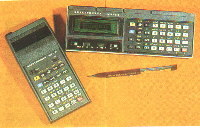 The calculator B3-34 and his(its) clone MK-54 and MK-56
of steel so popular, that the developers from the Kiev factory "Chip" have
decided(solved) to continue this line of calculators and in 1985 have released new models
MK-61 and MK-52. In them one register of memory is added, there were 105 steps of program
memory and ten of functions is added. The calculator MK-52, besides had memory on 512
cells, which was not cleared at turn off of power supply, and in which it was possible to
write both program, and datas. In the calculator MK-52 there was also special plug for
connection of available units with programs released under a common title BRP (the block
of the extension of memory). At development of blocks BRP the developers again have killed
at once two rabbits by one shot, inbonding in the block a matrix with two suites. Having
placed(installed) a cross connection,say, in a rule(situation) 1, we obtain the block
BRP-3 with a mathematical suite, and rebonding cross connection on a rule(situation) 2 -
the block BRP becomes astronavigation BRP-2. The warranty, truth, on the block thus was
lost, as it was necessary to turn off the screw with a seal. About it was told in one of
numbers " Sciences and Life ", where one of the readers has informed about it
with edition, to which in turn about it has told one of the developers from
"Chip". I present, that was then with this developer. By the way, the calculator
MK-52 flied to space by the ship " Union ТМ-7 ", where it(he) was supposed to
be used for account of a trajectory of landing(planting) in case the on-board computer
will deteriorate.
The calculator B3-34 and his(its) clone MK-54 and MK-56
of steel so popular, that the developers from the Kiev factory "Chip" have
decided(solved) to continue this line of calculators and in 1985 have released new models
MK-61 and MK-52. In them one register of memory is added, there were 105 steps of program
memory and ten of functions is added. The calculator MK-52, besides had memory on 512
cells, which was not cleared at turn off of power supply, and in which it was possible to
write both program, and datas. In the calculator MK-52 there was also special plug for
connection of available units with programs released under a common title BRP (the block
of the extension of memory). At development of blocks BRP the developers again have killed
at once two rabbits by one shot, inbonding in the block a matrix with two suites. Having
placed(installed) a cross connection,say, in a rule(situation) 1, we obtain the block
BRP-3 with a mathematical suite, and rebonding cross connection on a rule(situation) 2 -
the block BRP becomes astronavigation BRP-2. The warranty, truth, on the block thus was
lost, as it was necessary to turn off the screw with a seal. About it was told in one of
numbers " Sciences and Life ", where one of the readers has informed about it
with edition, to which in turn about it has told one of the developers from
"Chip". I present, that was then with this developer. By the way, the calculator
MK-52 flied to space by the ship " Union ТМ-7 ", where it(he) was supposed to
be used for account of a trajectory of landing(planting) in case the on-board computer
will deteriorate.
Late models of calculators
The first calculators consumed a lot of energies from batteries, which operation
sufficed from force at two hours of an off-line operation. 220 volts under a hand happen
not always, and without problems to buy batteries it was possible only in large cities.
Therefore engineers - developers have begun to develop calculators, which there is not
enough of energy from batteries. Liquid crystal displaies by then were already struck out
which differed by the reduced энерго-consumption.
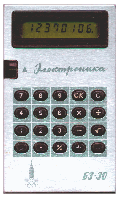 The second calculator on liquid crystals after B3-04 became the calculator
B3-30 (in a figure at the left), designed in 1978 and consuming 8 milliwatts (for
matching, the calculator B3-26 consumed 600 milliwatts). In this calculator there was a
function, unusual for the Soviet calculators, of calculation of reciprocal of number
available practically in all modern simple calculators. To calculate 1/5, it is necessary
to push | 5 | -:- | = |. In one year the calculator B3-30 has replaced B3-39, in which the
new lowlevel chip was used. The power consumption has decreased in eight times and has
made only one milliwatt. In this calculator already it was possible to do without a
converter of power. In one year, to the Moscow olympiad of 1980 the calculator MK-53,
having onboard hours with an alarm clock and stop watch was released. In this calculator
it was required on one battery less, than in B3-39. It became possible(probable) at the
expense of usage of even more lowlevel chip К145ВВ3-2, which besides became
"packageless". New mark in a calculator-building also became appearance of the
calculator with power supply from solar cells MK-60. In common, the usual calculator, has
one register of memory, except for solar batteries anything in it(him) singular is not
present.
The second calculator on liquid crystals after B3-04 became the calculator
B3-30 (in a figure at the left), designed in 1978 and consuming 8 milliwatts (for
matching, the calculator B3-26 consumed 600 milliwatts). In this calculator there was a
function, unusual for the Soviet calculators, of calculation of reciprocal of number
available practically in all modern simple calculators. To calculate 1/5, it is necessary
to push | 5 | -:- | = |. In one year the calculator B3-30 has replaced B3-39, in which the
new lowlevel chip was used. The power consumption has decreased in eight times and has
made only one milliwatt. In this calculator already it was possible to do without a
converter of power. In one year, to the Moscow olympiad of 1980 the calculator MK-53,
having onboard hours with an alarm clock and stop watch was released. In this calculator
it was required on one battery less, than in B3-39. It became possible(probable) at the
expense of usage of even more lowlevel chip К145ВВ3-2, which besides became
"packageless". New mark in a calculator-building also became appearance of the
calculator with power supply from solar cells MK-60. In common, the usual calculator, has
one register of memory, except for solar batteries anything in it(him) singular is not
present.
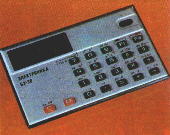 The engineering thought too in place . did not stand, and, deciding(solving)
the task of microminiaturization, in 1979 is developed new supersmall, but very clever
calculator B3-38. He(it) included all last reachings of microelectronics. His(its) sizes
were smallest - 91х55х5.5 mm. It(he) is skilful not only to be engineering, but also
manufactured statistical accounts. The calculator had two prefix keys - F1 and F2. The
similar calculator soon has appeared, but with sizes is larger - MK-51. Soon it(he) became
very popular, though he(it) had essential disadvantage - power switch, which all time
badly switched on. It was that our engineers have guessed to make the mechanism of
inclusions consisting of a semicircular shade slide, which closed tracks of printed wiring
on card. Certainly, in due course tracks окислались or were cleared, and the
contact became bad. In these calculators a method of calculation of elementary functions
on a method " digit behind digit " for the first time was applied which became
has replaced an expansion in a series Theilor and became the actual standard almost for
all modern calculators all over the world, except for as for us. In two words, method
" digit behind digit " is possible to attribute(relate) both to iterative, and
to tabulared. It(he) is characterized by a simplicity of execution of operations
(algebraic addition and shift), significant coincidence of algorithms for different
functions and, most important, high enough speed and accuracy by calculation. The error of
calculations at 8-bit argument makes all + - 1 in the seventh - eighth bit. And, at last,
one of the latest models among engineering calculators became the calculator MK-71 with
power supply from solar cells. It(he) as a matter of fact is prolongation(continuation) of
a series B3-38 and MK-51. In this calculator, as against B3-38 and MK-51, the algebraic
logic of calculations, same as well as in C3-15 is used, there are five levels of
brackets, possibility of operation with common fractions and to represent result of
calculations in degrees, minutes and seconds, there are hyperbolic functionses and
mechanism of roundoff of result to required accuracy. Besides this calculator - ten-bit.
The engineering thought too in place . did not stand, and, deciding(solving)
the task of microminiaturization, in 1979 is developed new supersmall, but very clever
calculator B3-38. He(it) included all last reachings of microelectronics. His(its) sizes
were smallest - 91х55х5.5 mm. It(he) is skilful not only to be engineering, but also
manufactured statistical accounts. The calculator had two prefix keys - F1 and F2. The
similar calculator soon has appeared, but with sizes is larger - MK-51. Soon it(he) became
very popular, though he(it) had essential disadvantage - power switch, which all time
badly switched on. It was that our engineers have guessed to make the mechanism of
inclusions consisting of a semicircular shade slide, which closed tracks of printed wiring
on card. Certainly, in due course tracks окислались or were cleared, and the
contact became bad. In these calculators a method of calculation of elementary functions
on a method " digit behind digit " for the first time was applied which became
has replaced an expansion in a series Theilor and became the actual standard almost for
all modern calculators all over the world, except for as for us. In two words, method
" digit behind digit " is possible to attribute(relate) both to iterative, and
to tabulared. It(he) is characterized by a simplicity of execution of operations
(algebraic addition and shift), significant coincidence of algorithms for different
functions and, most important, high enough speed and accuracy by calculation. The error of
calculations at 8-bit argument makes all + - 1 in the seventh - eighth bit. And, at last,
one of the latest models among engineering calculators became the calculator MK-71 with
power supply from solar cells. It(he) as a matter of fact is prolongation(continuation) of
a series B3-38 and MK-51. In this calculator, as against B3-38 and MK-51, the algebraic
logic of calculations, same as well as in C3-15 is used, there are five levels of
brackets, possibility of operation with common fractions and to represent result of
calculations in degrees, minutes and seconds, there are hyperbolic functionses and
mechanism of roundoff of result to required accuracy. Besides this calculator - ten-bit.
 There is one more direction of development of calculators -
demonstration calculators. As a matter of fact businesses, are usual calculators, in which
the large indicators and buttons are applied, switching aa?eiiiaua, which
"pushed" through a magnetic pick. For me one photo of the demonstration
calculator made on a basis MK-36 was saved only. In due time I have presented in school,
where the demonstration calculator by sizes meter on 1,5, compatible with MK-54 studied,,
but it(him) at the end of August have thrown out on a dustbin...
There is one more direction of development of calculators -
demonstration calculators. As a matter of fact businesses, are usual calculators, in which
the large indicators and buttons are applied, switching aa?eiiiaua, which
"pushed" through a magnetic pick. For me one photo of the demonstration
calculator made on a basis MK-36 was saved only. In due time I have presented in school,
where the demonstration calculator by sizes meter on 1,5, compatible with MK-54 studied,,
but it(him) at the end of August have thrown out on a dustbin...
Calculators - microcomputers
In the beginning 80 years become of PCs ever more. In 1983 there is a first Soviet PC
"Agat" with the processor 6502, at some schools start to teach the programming
languages.
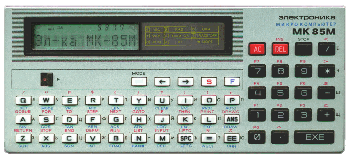 In 1986 there is a first Soviet calculator with the programming language of
"BASIC" - "Microcomputer" Elektronika MK-85 ". There is it(he)
not cheaply - 145 roubles, but all the same Electronics engineering " with Moscow and
Leningrad at once is swept away from counters of firm shops ", it is necessary to
it(him) to appear. Only by 1988 it(he) can quietly be bought in shop. It - not without
puprose - in the calculator is " of a BASIC " - programming language of the
present computers! MK-85 Was released in two variants - with kilobyte of memory (MK-85)
and with six (MK-85М). The calculator had a feature - worked with numbers, for which the
orders reached(achieved) + - 4096 degrees. The truth to take sine from number with the
order close to 4096, could reduce not only in hangup, but also to miss already of gated in
programs. The programs, by the way, were not cleared from memory of the calculator after
his(its) turn off - too novelty. In the usual mode the calculator works about -
о-о-чень slowly. So for example, for calculation of sine from number 3 it is
required to it(him) of the whole 3.5 seconds. The calculator can be translated about the
mode " of the accelerated calculations ". For this purpose at the moment of
his(its) inclusion it is necessary to push the key "+". Then it(he)
considers(counts) very fast. Same sine it(he) "takes" for 0,5 seconds, but thus
the batteries literally "decay" on eyes, and they very soon need to be changed.
Such mode of operation is recommended by operation from the external power supply. In the
calculator there is a 16-bit indicator, and in one string(line) up to 63 characters can go
in. The input up to 10 programs of the user is stipulated, and the gated in program can be
debugged in the mode of debugging. Besides in the calculator there are 26 registers of
memory, which number can be enlarged at the expense of decrease of memory for programs. It
is very interesting, that in such perspective calculator the elementary mathematical
functions are evaluated by an expansion in a series Theilor, instead of on a method "
Digit behind digit ", that is a little strange. Though much strange can become
completely clear, if you will read up this paper up to the end.
In 1986 there is a first Soviet calculator with the programming language of
"BASIC" - "Microcomputer" Elektronika MK-85 ". There is it(he)
not cheaply - 145 roubles, but all the same Electronics engineering " with Moscow and
Leningrad at once is swept away from counters of firm shops ", it is necessary to
it(him) to appear. Only by 1988 it(he) can quietly be bought in shop. It - not without
puprose - in the calculator is " of a BASIC " - programming language of the
present computers! MK-85 Was released in two variants - with kilobyte of memory (MK-85)
and with six (MK-85М). The calculator had a feature - worked with numbers, for which the
orders reached(achieved) + - 4096 degrees. The truth to take sine from number with the
order close to 4096, could reduce not only in hangup, but also to miss already of gated in
programs. The programs, by the way, were not cleared from memory of the calculator after
his(its) turn off - too novelty. In the usual mode the calculator works about -
о-о-чень slowly. So for example, for calculation of sine from number 3 it is
required to it(him) of the whole 3.5 seconds. The calculator can be translated about the
mode " of the accelerated calculations ". For this purpose at the moment of
his(its) inclusion it is necessary to push the key "+". Then it(he)
considers(counts) very fast. Same sine it(he) "takes" for 0,5 seconds, but thus
the batteries literally "decay" on eyes, and they very soon need to be changed.
Such mode of operation is recommended by operation from the external power supply. In the
calculator there is a 16-bit indicator, and in one string(line) up to 63 characters can go
in. The input up to 10 programs of the user is stipulated, and the gated in program can be
debugged in the mode of debugging. Besides in the calculator there are 26 registers of
memory, which number can be enlarged at the expense of decrease of memory for programs. It
is very interesting, that in such perspective calculator the elementary mathematical
functions are evaluated by an expansion in a series Theilor, instead of on a method "
Digit behind digit ", that is a little strange. Though much strange can become
completely clear, if you will read up this paper up to the end.
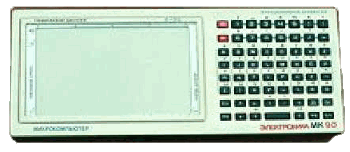 And, at last, completes our historical digression about a world of
calculators - super-calculator MK-90 - child of the Minsk factory "Chip". I have
not enough of information on this calculator owing to absence it(him) in my instruction. I
shall tell only, that it is the calculator with a BASIC, and large graphics screen. It(he)
has the 16-bit processor compatible to Elektronika 60, RAM - 16 kilobytes, ROM - 16
kilobytes (user is accessible 11824 bytes). The display - 120 х 64 points (8
strings(lines) till 20 characters). On it the evolution of calculators is completed, as
though we would like it. The Minsk factory "Chip" continues to release MK-90,
releases some more simple calculators of a series MC. Our Russian factories, similar,
completely have minimized production of calculators. The import models for a long time
have escaped far forwards. For them norm became presence of 32 kilobytes of memory, large
graphics, or even the color display, link with the computer and decent speed.
And, at last, completes our historical digression about a world of
calculators - super-calculator MK-90 - child of the Minsk factory "Chip". I have
not enough of information on this calculator owing to absence it(him) in my instruction. I
shall tell only, that it is the calculator with a BASIC, and large graphics screen. It(he)
has the 16-bit processor compatible to Elektronika 60, RAM - 16 kilobytes, ROM - 16
kilobytes (user is accessible 11824 bytes). The display - 120 х 64 points (8
strings(lines) till 20 characters). On it the evolution of calculators is completed, as
though we would like it. The Minsk factory "Chip" continues to release MK-90,
releases some more simple calculators of a series MC. Our Russian factories, similar,
completely have minimized production of calculators. The import models for a long time
have escaped far forwards. For them norm became presence of 32 kilobytes of memory, large
graphics, or even the color display, link with the computer and decent speed.
Rare models of calculators
To rare models of calculators it is necessary to attribute(relate) not only very old
models of calculators, which for a long time already have demolished on a dustbin, and
models, which were released only by trial batches, or which were very fast removed from
production. In main, I have not enough of information on such calculators, sometimes even
the information is obtained only from a mention in the books. All first Soviet calculators
fulfilled with usage of transistors, ферро-transistors or microassemblies - very
rare. From calculators of a beginning 70 years very rare model - Iskra 1122 with the
CRT-display. The first rare model among pocket and later calculators - model B3-18. At
once after its(her) release has appeared B3-18А, and B3-18 is removed from production.
Same it is possible to tell and about B3-19 (B3-19М). The experimental batches of
calculators with the red indicator as light-emitting diodes were released. It is models
B3-09, B3-26А, B3-36А.
 Very
rare model - unique(sole) Soviet calculator with a printing station - MK-40, which was
only in pilot production and never acted in mass sale. Also I want to mention and about
MK-47. This calculator is made in similar tank with B3-21, and allowed to write programs
of the user to magnetic cards. Among late models by trial batches in 1982 (!) The
calculator " Elektronika SP " was released which represented a pocket dictionary
- translator. It(he) stored in memory till 1000 words from Russian, English and German
languages. Apart from it in it(him) there was a calculator, review of all words starting
from any character, call on the indicator of one of 52 completed or unfinished phrases,
and also call of words and phrases on 11 themes. The calculator had 15-segment 16-bit
indicator and worked only from five volts. This device was made on the basis of a
monolithic microprocessor К1801ВЕ1 and had 64кBит ROM such as К596РЕ1.
Very
rare model - unique(sole) Soviet calculator with a printing station - MK-40, which was
only in pilot production and never acted in mass sale. Also I want to mention and about
MK-47. This calculator is made in similar tank with B3-21, and allowed to write programs
of the user to magnetic cards. Among late models by trial batches in 1982 (!) The
calculator " Elektronika SP " was released which represented a pocket dictionary
- translator. It(he) stored in memory till 1000 words from Russian, English and German
languages. Apart from it in it(him) there was a calculator, review of all words starting
from any character, call on the indicator of one of 52 completed or unfinished phrases,
and also call of words and phrases on 11 themes. The calculator had 15-segment 16-bit
indicator and worked only from five volts. This device was made on the basis of a
monolithic microprocessor К1801ВЕ1 and had 64кBит ROM such as К596РЕ1.
Errors and features of calculators
It is a little about errors and features. Taking into account specificity of
development of the Soviet calculators, including geopolitical aspects, can become is
clear, that if our developers developed the calculator, not leaning(basing) on results of
level-by-level scanning of chips of import clones, they permanently brought in any snap to
their operation. It were both error of calculations of calculators, and interesting finds.
In the set of calculators of a series B3-26 (B3-23, B3-24Г, MK-57) the square roots from
negative numbers were evaluated. The radical from -4 was equal -2. In the calculator
B3-32, the developers, having seen, that on the indicator are the not involved point at
the left, have decided(solved) her(it) to involve. For this model the point at the left
lights up at pressing the key. Have pushed - lights up, have released(let off) - dies
away. More - anything. In the calculator B3-21 the developers have included the function  , which result in the register Y sine of
argument, and in the register X - cosine was located with. By simple division we obtain a
tangent. Very conveniently. However, in first printings of these calculators the error was
watched: at addition of number containing in a mantissa seven "9", and in the
eighth bit, which is not displayed - digit, large four, there is an error. In these models
if to fold 9.9999999 and 10 it turns out 120. At execution of complex(difficult)
operations like sine one of the registers of the ring stack could deteriorate. For check
after inclusion of the calculator it is possible to type | 2 | P | sin | P |, |. If on the
indicator lights up 1. -00, the calculator has such error. Well, and some models
irregularly transferred (more precisely, did not transfer) to the subroutine, if the
operator PP is brought in cell of program memory with the address 55, 65, 70, 80, 91 and
92, and the operator is fulfilled, which code is equal to the pointer of transition to the
subroutine. Slightly not clearly, but if to the address 55 costs(stands) | PP | 9 | 9 | C/P
|, instead of proceeding(passing) to the address 93 (key code | 9 | - 94), the calculator
will bring in the register X number 99, it can call(cause) easy bewilderment owing to
nervous failure for the man, which is sure, that has written the program correctly. The
curious users can find in the calculator MK-71 one very remarkable feature. She(it) is
coupled to switching of the switch of degrees - радианов-градов in a
midposition - between degrees and radians or between radians and градами. Thus the
calculator passes in a very unusual mode of operation reminding operation with the
calculator MK-51. First, now numbers in the calculator have a mantissa of length 8 instead
of ten, though the missing bits are stored in memory, but are not visible. Secondly, some
control buttons have other value! The key with the map of degrees now evaluates return
value of number, in a combination to the key F - factorial. The key 1/x - switches a way
of calculation of trigonometrical functions (degrees - радианы-грады). On the
indicator they are mapped accordingly by tags "F", "P", "K"!
In a combination to the "F" key the key 1/x now enters the mode of statistical
calculations. The "hyp" key now enters the information in degrees, minutes and
seconds, and back in a combination to the "F" key. For indication of number were
in memory, mode of the "F" key and the calculations with a constant are used
segments of the most left bit. Well and, certainly, all known B3-34. This calculator has
the great many of errors and features in operation. I shall point only some errors, which
in one book were called as features, which "... Are a consequence not of errors of
the developers of the calculator, and their attempts to find the compromise between the
requirements of a software and simplicity of a construction ". In a programmed mode
of operation the functional operators before the operator /-/ of change of the sign are
not fulfilled. After execution of the subroutine ended by some operators, instead of the
operator В/0, the operator, following it(him) is fulfilled. Such "feature". The
operator x^Y was fulfilled incorrectly at some values of operands. For an example it is
possible to enter | 5 | 5 | 5 | 5 |
, which result in the register Y sine of
argument, and in the register X - cosine was located with. By simple division we obtain a
tangent. Very conveniently. However, in first printings of these calculators the error was
watched: at addition of number containing in a mantissa seven "9", and in the
eighth bit, which is not displayed - digit, large four, there is an error. In these models
if to fold 9.9999999 and 10 it turns out 120. At execution of complex(difficult)
operations like sine one of the registers of the ring stack could deteriorate. For check
after inclusion of the calculator it is possible to type | 2 | P | sin | P |, |. If on the
indicator lights up 1. -00, the calculator has such error. Well, and some models
irregularly transferred (more precisely, did not transfer) to the subroutine, if the
operator PP is brought in cell of program memory with the address 55, 65, 70, 80, 91 and
92, and the operator is fulfilled, which code is equal to the pointer of transition to the
subroutine. Slightly not clearly, but if to the address 55 costs(stands) | PP | 9 | 9 | C/P
|, instead of proceeding(passing) to the address 93 (key code | 9 | - 94), the calculator
will bring in the register X number 99, it can call(cause) easy bewilderment owing to
nervous failure for the man, which is sure, that has written the program correctly. The
curious users can find in the calculator MK-71 one very remarkable feature. She(it) is
coupled to switching of the switch of degrees - радианов-градов in a
midposition - between degrees and radians or between radians and градами. Thus the
calculator passes in a very unusual mode of operation reminding operation with the
calculator MK-51. First, now numbers in the calculator have a mantissa of length 8 instead
of ten, though the missing bits are stored in memory, but are not visible. Secondly, some
control buttons have other value! The key with the map of degrees now evaluates return
value of number, in a combination to the key F - factorial. The key 1/x - switches a way
of calculation of trigonometrical functions (degrees - радианы-грады). On the
indicator they are mapped accordingly by tags "F", "P", "K"!
In a combination to the "F" key the key 1/x now enters the mode of statistical
calculations. The "hyp" key now enters the information in degrees, minutes and
seconds, and back in a combination to the "F" key. For indication of number were
in memory, mode of the "F" key and the calculations with a constant are used
segments of the most left bit. Well and, certainly, all known B3-34. This calculator has
the great many of errors and features in operation. I shall point only some errors, which
in one book were called as features, which "... Are a consequence not of errors of
the developers of the calculator, and their attempts to find the compromise between the
requirements of a software and simplicity of a construction ". In a programmed mode
of operation the functional operators before the operator /-/ of change of the sign are
not fulfilled. After execution of the subroutine ended by some operators, instead of the
operator В/0, the operator, following it(him) is fulfilled. Such "feature". The
operator x^Y was fulfilled incorrectly at some values of operands. For an example it is
possible to enter | 5 | 5 | 5 | 5 |  | Х | 4 |
| Х | 4 |  | F |
X^Y|. If is highlighted 39.062487, the operator x^y is evaluated irregularly. These - that
the errors in a consequence were corrected, but there were errors of exponentation of
negative numbers in the whole degree, the calculator MK-61 and MK-52 considered(counted) a
zero as largest in a world by number at function evaluation of finding maximum of two
numbers | K | max |.
| F |
X^Y|. If is highlighted 39.062487, the operator x^y is evaluated irregularly. These - that
the errors in a consequence were corrected, but there were errors of exponentation of
negative numbers in the whole degree, the calculator MK-61 and MK-52 considered(counted) a
zero as largest in a world by number at function evaluation of finding maximum of two
numbers | K | max |.
Borrowing of calculators
To not devise a bicycle, some models of the Soviet calculators were obviously borrowed
from western clones. It is already difficult to place(install), how there was a borrowing
- level-by-level scanning of chips, industrial espionage or purchase of the
"know-how". Below I shall try to reduce only list of the Soviet calculators
"very similar" to western.
To Guy Ball: for publication of photos of western calculators it is
necessary to receive permission from their writers.
Elektronika 68 (ДД) vs Sharp "Compet 20".
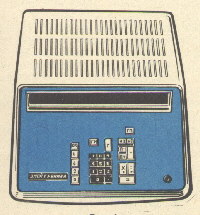
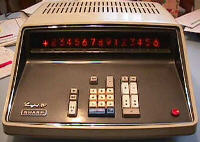
Elektronika B3-04 vs Sharp EL-805.


Rockwell 61R и Elektronika B3-18A
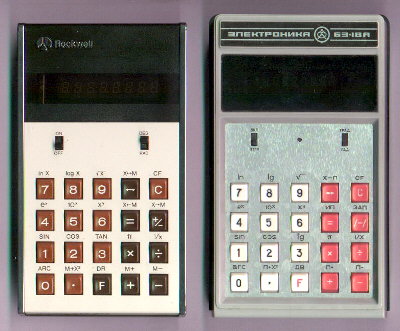
The large series of calculators had design similar with General EZ2000.
Elektronika B3-23 and General EZ2000

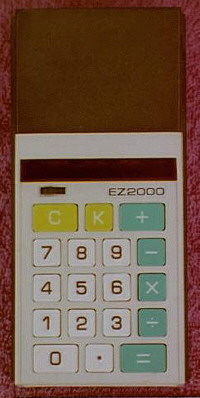
Elektronika B3-35 and HANIMEX ESR Mater


Elektronika B3-36 used design from Rockwell "The 22K"


Elektronika B3-38 and CASIO FX-48


Elektronika MK 40 and SERD 21PD-N


Elektronika MK-51 and CASIO FX-2500


Epilogue
Well that's all.
Please visit my site devoted to collecting of calculators: http://www.geocities.com/SiliconValley/1061/calcolle.htm.
Good luck!
Sergei Frolov
All images of Soviet calculators are copyright © Sergei Frolov,
1998-1999
Last changes: 04.07.99
Используются технологии
uCoz The first mechanical fitting in Russia for automation of accounts
were abacuses. This "the national calculator" has held on workstations of the
cashiers in shops down to middle of the ninetieth years. It is interesting to mark, that
in the textbook "Trade calculations" (1986) the whole chapter is devoted to
methods of calculation on the abacuses. Abacuses represent the wooden basis, on which the
metal rods are hardened, on which the wooden beads are strung. On each rod ten beads are,
except for a separator of roubles and copecks, on which four beads are. Before the
beginning of calculations all beads are moved on the right side, as shown in a figure.
Input of number start from the most significant digits of roubles, removing necessary
quantity of beads by the right hand. Abacuses are intended for addition and subtraction,
and at the defined skill the speed of execution of calculations can exceed speed of
execution of the same calculations, but with usage of the calculator. Simultaneously with
abacuses, in scientific circles, still with pre-revolutionary (before 1917) times, with
success used slide rules, which with XVII of century practically without changes worked
down to appearance of calculators. The collecting of slide rules - too very fascinating
hobby, to which can be devoted separate article. Trying how to automize the process of
calculations, the mankind starts to devise mechanical counting devices. Even known Russian
mathematician the Chebyshev in the end XIX of century has offered the model of the
calculator.
The first mechanical fitting in Russia for automation of accounts
were abacuses. This "the national calculator" has held on workstations of the
cashiers in shops down to middle of the ninetieth years. It is interesting to mark, that
in the textbook "Trade calculations" (1986) the whole chapter is devoted to
methods of calculation on the abacuses. Abacuses represent the wooden basis, on which the
metal rods are hardened, on which the wooden beads are strung. On each rod ten beads are,
except for a separator of roubles and copecks, on which four beads are. Before the
beginning of calculations all beads are moved on the right side, as shown in a figure.
Input of number start from the most significant digits of roubles, removing necessary
quantity of beads by the right hand. Abacuses are intended for addition and subtraction,
and at the defined skill the speed of execution of calculations can exceed speed of
execution of the same calculations, but with usage of the calculator. Simultaneously with
abacuses, in scientific circles, still with pre-revolutionary (before 1917) times, with
success used slide rules, which with XVII of century practically without changes worked
down to appearance of calculators. The collecting of slide rules - too very fascinating
hobby, to which can be devoted separate article. Trying how to automize the process of
calculations, the mankind starts to devise mechanical counting devices. Even known Russian
mathematician the Chebyshev in the end XIX of century has offered the model of the
calculator. The most popular mechanical calculator in the Soviet
times was the adding machine of the system Odhner "Felix". At the left - map of
an adding machine taken from the "Small Soviet encyclopedia" of 1932. On this
adding machine it was possible to manufacture four arithmetic operations - addition,
subtraction, multiplying and division. In later models, for example, "Felix-М",
it is possible to see toddlers for the indicating of a rule of a comma and more convenient
crandle for shift of the carriage. For production of calculations it was necessary to turn
a pen - once for addition or subtraction, and some times for multiplying and division.
The most popular mechanical calculator in the Soviet
times was the adding machine of the system Odhner "Felix". At the left - map of
an adding machine taken from the "Small Soviet encyclopedia" of 1932. On this
adding machine it was possible to manufacture four arithmetic operations - addition,
subtraction, multiplying and division. In later models, for example, "Felix-М",
it is possible to see toddlers for the indicating of a rule of a comma and more convenient
crandle for shift of the carriage. For production of calculations it was necessary to turn
a pen - once for addition or subtraction, and some times for multiplying and division. Once, certainly to twist a pen it is possible, and even it is
interesting, but what to do, if you work the bookkeeper, and for day it is necessary to
perform hundreds simple operations? And the noise from twisting counters stands decent,
especially, if simultaneously in a location with adding machines some man works. However,
in due course to twist a pen has bothered, and the human mind(wit) has struck out
electrical accounting machines, which arithmetic operations manufactured automatically or
is semi-automatic. On the right - map of the multikeyboard computer, popular per 50 years,
VMM-2 ("Goods dictionary", VIII volume, 1960). This model had nine bits and
worked up to 17 order. It had overall dimensions 440x330x240 mm and mass in 23 kgs.
Once, certainly to twist a pen it is possible, and even it is
interesting, but what to do, if you work the bookkeeper, and for day it is necessary to
perform hundreds simple operations? And the noise from twisting counters stands decent,
especially, if simultaneously in a location with adding machines some man works. However,
in due course to twist a pen has bothered, and the human mind(wit) has struck out
electrical accounting machines, which arithmetic operations manufactured automatically or
is semi-automatic. On the right - map of the multikeyboard computer, popular per 50 years,
VMM-2 ("Goods dictionary", VIII volume, 1960). This model had nine bits and
worked up to 17 order. It had overall dimensions 440x330x240 mm and mass in 23 kgs. In 1961 at an exhibition of industrial reachings in England first
was demonstrated the world's first electronic calculator Anita MK-8 (England). On ending
an exhibition it is accepted decision to create domestic, completely electronic
calculator. Since 1961 a group of the scientific employees of the "Leningrad
separation of Central economic-mathematical institute of an Academy of sciences USSR"
are V. Marakhovsky, E. Kanevsky, G. Menderskaya, have begun to develop the first Soviet
electronic calculator, which has received a name "Vega". In November, 1962 the
calculator has works. On trials of a State commission were represented three created
simultaneously calculators under names "Vega", "Lada" and
"Vyatka-E". On the carried out(spent) trials has won "Vega", which was
decided to manufacture. On the created calculator by group of the developers the copyright
Certificate with priority on May 9, 1963 was obtained. To manufacture the calculator began
a Kursk Factory of accounting Machines (Schetmasch), which has placed on front The panel
of the calculator the emblem K3CM (cyrillic symbols). The electronic keyboard computing
machine (EKVM) "Vega" was serially released since 1964 and is intended for mass
usage at nonproduction accounts.
In 1961 at an exhibition of industrial reachings in England first
was demonstrated the world's first electronic calculator Anita MK-8 (England). On ending
an exhibition it is accepted decision to create domestic, completely electronic
calculator. Since 1961 a group of the scientific employees of the "Leningrad
separation of Central economic-mathematical institute of an Academy of sciences USSR"
are V. Marakhovsky, E. Kanevsky, G. Menderskaya, have begun to develop the first Soviet
electronic calculator, which has received a name "Vega". In November, 1962 the
calculator has works. On trials of a State commission were represented three created
simultaneously calculators under names "Vega", "Lada" and
"Vyatka-E". On the carried out(spent) trials has won "Vega", which was
decided to manufacture. On the created calculator by group of the developers the copyright
Certificate with priority on May 9, 1963 was obtained. To manufacture the calculator began
a Kursk Factory of accounting Machines (Schetmasch), which has placed on front The panel
of the calculator the emblem K3CM (cyrillic symbols). The electronic keyboard computing
machine (EKVM) "Vega" was serially released since 1964 and is intended for mass
usage at nonproduction accounts. The
calculator fulfils four arithmetic operations, division of integers, translation of
fraction, exponentiation, multiplying on a constant factor and rootsquaring (!). In
the calculator was used about 1500 transistor-magnetic units.
The
calculator fulfils four arithmetic operations, division of integers, translation of
fraction, exponentiation, multiplying on a constant factor and rootsquaring (!). In
the calculator was used about 1500 transistor-magnetic units.
 To the beginning of production of calculators,
in USSR be not struck out yet neither nixie tube displays, nor fluorescent. For the
calculator "Vega" the electroluminescent (fluorescent) display with personal
segments for displaying one digit was specially developed. Probably, this is first in a
world usage of a seven-segment display intended for for the displaying one digit. In
western calculator Friden 130 (1963) the similar display was used, but it had not the
unique seven-segment display for displaying one digit.
To the beginning of production of calculators,
in USSR be not struck out yet neither nixie tube displays, nor fluorescent. For the
calculator "Vega" the electroluminescent (fluorescent) display with personal
segments for displaying one digit was specially developed. Probably, this is first in a
world usage of a seven-segment display intended for for the displaying one digit. In
western calculator Friden 130 (1963) the similar display was used, but it had not the
unique seven-segment display for displaying one digit. In the calculator "Rasa", which name is
written by a Latinic symbols, the unique stroboscopic display was applied. The essence of
the display was represented by(with) a drum which is resulted in driving by the motor,
spinned with frequency 1300 turnovers one minute (see fig.). Inside the calculator the
thyratrons are placed which flare during 100 us for ignition of the defined sign. In the
same calculator the Reverse Polish Notation (RPN) for execution of calculations was
applied. It means, that two numbers at first are entered, but only then the key with
required operation is pushed.
In the calculator "Rasa", which name is
written by a Latinic symbols, the unique stroboscopic display was applied. The essence of
the display was represented by(with) a drum which is resulted in driving by the motor,
spinned with frequency 1300 turnovers one minute (see fig.). Inside the calculator the
thyratrons are placed which flare during 100 us for ignition of the defined sign. In the
same calculator the Reverse Polish Notation (RPN) for execution of calculations was
applied. It means, that two numbers at first are entered, but only then the key with
required operation is pushed.
 At the end of 60 years a series of the first calculators with name
"Iskra" (Spark) set is developed. It - calculators a Iskra 11 (1969), Iskra 12
(1969) and Iskra 22 (1969). In these calculators used nixie tube display and first
microassemblies (see fig.) of units under a title "MIR-10" ("Mir" mean
two equal means "World" or "Peace" in Russian) were already applied.
At the end of 60 years a series of the first calculators with name
"Iskra" (Spark) set is developed. It - calculators a Iskra 11 (1969), Iskra 12
(1969) and Iskra 22 (1969). In these calculators used nixie tube display and first
microassemblies (see fig.) of units under a title "MIR-10" ("Mir" mean
two equal means "World" or "Peace" in Russian) were already applied.
 Iskra 1122 still is necessary
to pay attention to the extremely interesting calculator. This calculator was made on the
basis of the calculator a Iskra 112, but used the CRT-display is applied on the
basis of the cathode-ray tube. Simultaneously on the display contents of the operating
register and registers of memory are displayed. At mapping thousand are separated from
each other by blank, that is very convenient for perception. By the way, this calculator
was one of the most expensive released calculators with the price in 4,100 roubles
(cheapest automobile in those times had cost 3,600 roubles).
Iskra 1122 still is necessary
to pay attention to the extremely interesting calculator. This calculator was made on the
basis of the calculator a Iskra 112, but used the CRT-display is applied on the
basis of the cathode-ray tube. Simultaneously on the display contents of the operating
register and registers of memory are displayed. At mapping thousand are separated from
each other by blank, that is very convenient for perception. By the way, this calculator
was one of the most expensive released calculators with the price in 4,100 roubles
(cheapest automobile in those times had cost 3,600 roubles). In August, 1973 the electronic industry of our country has put
the task for one year to create the electronic pocket calculator on a microprocessor LSI
circuit and with the liquid crystal indicator. Above this very complex(difficult) task
worked group of 27 men. The huge operation was coming: to make the drawings, circuit
and templates consisting from 144 thousand of points to place the microprocessor with 3400
units in a chip by a size 5х5 mm. In five months of operation the first samples of the
calculator were ready, and in nine months, three months prior to a target date, the
electronic pocket calculator under a title « Elektronika B3-04 » was handed over to a
state commission. Already in the beginning of 1974 the electronic gnome has arrived in
sale. It was the large labour victory which has shown possibilities of our electronic
industry.
In August, 1973 the electronic industry of our country has put
the task for one year to create the electronic pocket calculator on a microprocessor LSI
circuit and with the liquid crystal indicator. Above this very complex(difficult) task
worked group of 27 men. The huge operation was coming: to make the drawings, circuit
and templates consisting from 144 thousand of points to place the microprocessor with 3400
units in a chip by a size 5х5 mm. In five months of operation the first samples of the
calculator were ready, and in nine months, three months prior to a target date, the
electronic pocket calculator under a title « Elektronika B3-04 » was handed over to a
state commission. Already in the beginning of 1974 the electronic gnome has arrived in
sale. It was the large labour victory which has shown possibilities of our electronic
industry.
 So, we shall take, for example, calculator C3-07. The very
surprising calculator, especially, his(its) keyboard and display. As it is visible from a
picture, on the calculator are combined not only key | + = | and | - = |, but also to
multiply - divide | X -:- |. Try to guess, as on this calculator to multiply and to
divide. The hint: the calculator does not perceive two pressing one key, one is possible
only.
So, we shall take, for example, calculator C3-07. The very
surprising calculator, especially, his(its) keyboard and display. As it is visible from a
picture, on the calculator are combined not only key | + = | and | - = |, but also to
multiply - divide | X -:- |. Try to guess, as on this calculator to multiply and to
divide. The hint: the calculator does not perceive two pressing one key, one is possible
only. The answer is not less surprising: to manufacture,say, multiplying 2 on 3, it
is necessary to push keys | 2 | X-:- | 3 | + = |, and to divide 2 on 3, it is necessary to
push keys: | 2 | X-:- | 3 | - = |. The addition and subtraction occurs similarly to
calculator B3-04, that is, the obtaining of a difference 2 - 3 will be evaluated so: | 2 |
+ = | 3 | - = |. In some models of this calculator it is possible to meet and surprising
eight-segment indicator. Since this model of calculators, all simple calculators
Светлановского of a factory operate with numbers with the orders up to
10e16-1, even if on the display is located eight or twelve bits. If the result exceeds 8
or 12 bits (depending on model), the comma fades and on the display there are first 8 or
12 bits of number. Speaking about the language of operation with microcalculators of first
printings, it is necessary to mention and calculators B3-02, B3-05 and B3-11. It - mark of
old calculators such as "Iskra" of 110 series. In these calculators at
calculations all bits of the indicator permanently shine. In main, certainly, zero&.
It is very inconvenient to retrieve on such calculators first (and last) significant bit.
By the way, in model C3-07, about which was spoken earlier, already there was an attempt
to decide(solve) this problem, though and a little bit unusual way - on this calculator
the zero has half of height. So, these three calculators had very inconvenient, but
feature, quite explained for early calculators: the required accuracy of calculations is
set at input of the first. That is, if it is necessary,say, to calculate a quotient from
division 23 on 32 to within three signs after a comma, the number 23 is necessary for
entering with three signs after a comma: | 23,000 | -:- | 32 | = | (0.718). So long as the
operator will not push the button of reset, all subsequent calculations will be
manufactured with three signs after a comma, and the comma in general does not go anywhere
more. It, by the way, also is named " as the fixed comma ", and later
calculators, in which the comma is already transferred on the display, then were named
" from a floating point ". Now, in a terminology there were changes, as a result
of which from "floating point" mappings number with a mantissa at the left and
order on the right now are named.
The answer is not less surprising: to manufacture,say, multiplying 2 on 3, it
is necessary to push keys | 2 | X-:- | 3 | + = |, and to divide 2 on 3, it is necessary to
push keys: | 2 | X-:- | 3 | - = |. The addition and subtraction occurs similarly to
calculator B3-04, that is, the obtaining of a difference 2 - 3 will be evaluated so: | 2 |
+ = | 3 | - = |. In some models of this calculator it is possible to meet and surprising
eight-segment indicator. Since this model of calculators, all simple calculators
Светлановского of a factory operate with numbers with the orders up to
10e16-1, even if on the display is located eight or twelve bits. If the result exceeds 8
or 12 bits (depending on model), the comma fades and on the display there are first 8 or
12 bits of number. Speaking about the language of operation with microcalculators of first
printings, it is necessary to mention and calculators B3-02, B3-05 and B3-11. It - mark of
old calculators such as "Iskra" of 110 series. In these calculators at
calculations all bits of the indicator permanently shine. In main, certainly, zero&.
It is very inconvenient to retrieve on such calculators first (and last) significant bit.
By the way, in model C3-07, about which was spoken earlier, already there was an attempt
to decide(solve) this problem, though and a little bit unusual way - on this calculator
the zero has half of height. So, these three calculators had very inconvenient, but
feature, quite explained for early calculators: the required accuracy of calculations is
set at input of the first. That is, if it is necessary,say, to calculate a quotient from
division 23 on 32 to within three signs after a comma, the number 23 is necessary for
entering with three signs after a comma: | 23,000 | -:- | 32 | = | (0.718). So long as the
operator will not push the button of reset, all subsequent calculations will be
manufactured with three signs after a comma, and the comma in general does not go anywhere
more. It, by the way, also is named " as the fixed comma ", and later
calculators, in which the comma is already transferred on the display, then were named
" from a floating point ". Now, in a terminology there were changes, as a result
of which from "floating point" mappings number with a mantissa at the left and
order on the right now are named. In one year after development of the first pocket microcalculator B3-04 more
perfect models pocket MK have appeared new. It - model B3-09М, B3-14 and B3-14М. These
calculators were made on one chip of the processor К145ИК2 and one chip of the
generator of phases. The calculator B3-09М at the left is shown, in the same tank is made
and B3-14М, on the right - B3-14.
In one year after development of the first pocket microcalculator B3-04 more
perfect models pocket MK have appeared new. It - model B3-09М, B3-14 and B3-14М. These
calculators were made on one chip of the processor К145ИК2 and one chip of the
generator of phases. The calculator B3-09М at the left is shown, in the same tank is made
and B3-14М, on the right - B3-14.  On these models there was already
"standard" language of operation on calculators, including calculations with a
constant. These calculators already could work both from a power supply unit, and from
four (B3-09М, B3-14М) or three (B3-14) of units such as АА. Though these calculators
are made on one about the same chip, but had different functionalities. And in general,
"уBирание" of different functions was inherent in many models of the
Soviet microcalculators. For example, the microcalculator B3-09М did not have sign of
calculation of the square root, B3-14М is not skilful to evaluate percents. Feature of
these simple calculators was that the comma borrowed(occupied) separate bit. It is very
convenient for fluent reading of the information, but thus the last sign bit disappears.
For the same calculators before the beginning of operation it is necessary to push the
"C" key for clearing the registers.
On these models there was already
"standard" language of operation on calculators, including calculations with a
constant. These calculators already could work both from a power supply unit, and from
four (B3-09М, B3-14М) or three (B3-14) of units such as АА. Though these calculators
are made on one about the same chip, but had different functionalities. And in general,
"уBирание" of different functions was inherent in many models of the
Soviet microcalculators. For example, the microcalculator B3-09М did not have sign of
calculation of the square root, B3-14М is not skilful to evaluate percents. Feature of
these simple calculators was that the comma borrowed(occupied) separate bit. It is very
convenient for fluent reading of the information, but thus the last sign bit disappears.
For the same calculators before the beginning of operation it is necessary to push the
"C" key for clearing the registers.  Following huge step in a history of development of calculators
became appearance of the first Soviet engineering calculator. At the end of 1975 in the
Soviet Union the first engineering calculator B3-18 was created. As wrote in this occasion
a magazine " a Science and Life " 10, 1976 in paper " a Fantastic
electronics engineering ": "... This calculator has passed a Rubicon of
arithmetics, his(its) mathematical derivation has stepped in trigonometry and algebra.
" The electronics Engineering B3-18 " knows how instantly to erect in guadrate
and to extract the square root, in two receptions(tricks) to erect in any degree in limits
of eight bits, to evaluate reciprocals, to evaluate the logarithms and antilogarithms,
trigonometrical functions... ", ".. .. When see, how the computer, which just
instantly added huge numbers, spends some seconds to fulfil any algebraic or
trigonometrical operation, involuntarily reflect on that large operation, which goes
inside a small box, before on its(her) indicator the result " will be lighted. And is
real, the huge operation was done. In a uniform chip by a size 5 х 5,2 mm were possible
to contain 45000 transistors, resistors, capacitors and explorers, that is half-hundreds
TV sets of that time have pushed in one section of an arithmetic writting-book! However,
and the price of such calculator was considerable - 220 roubles in 1978. For an example,
the engineer after termination(ending) institute in those times received 120 roubles per
one month. But the purchase cost that. Now it is not necessary to think how to not bring
down a shade slide of a slide rule, it is not necessary to care of an error, it is
possible to desert on a shelf of a table of logarithms. By the way, in this calculator the
key of the prefix "F" function for the first time was applied. Nevertheless in a
chip К145ИP7 of the calculator B3-18 it was not possible completely to contain
everything, that would be desirable. For example, at function evaluation, in which the
expansion in a series Theilor was used, the working register was cleared, therefore the
previous result of the operation was cleared. In this connection it was impossible to
manufacture the continiouses of calculation, such as 5 + sin 2. For this purpose at first
it was necessary to receive sine from two, and then only to add to result 5. So, the
operation is done large, the large efforts are spent, and as a result has appeared good,
but very dear(expensive) calculator. That the calculator was accessible to mass layers of
the population, the solution was accepted on the basis of the calculator B3-18А to make
cheaper model. To not devise a bicycle, our engineers transmit on the easiest paths. They
have taken and have removed the key of the prefix "F" function from the
calculator. The calculator has turned in usual, has received a title "B3-25А"
and became to accessible wide layers of the population. And only developers and repairmen
of calculators knew secret of alteration B3-25А.
Following huge step in a history of development of calculators
became appearance of the first Soviet engineering calculator. At the end of 1975 in the
Soviet Union the first engineering calculator B3-18 was created. As wrote in this occasion
a magazine " a Science and Life " 10, 1976 in paper " a Fantastic
electronics engineering ": "... This calculator has passed a Rubicon of
arithmetics, his(its) mathematical derivation has stepped in trigonometry and algebra.
" The electronics Engineering B3-18 " knows how instantly to erect in guadrate
and to extract the square root, in two receptions(tricks) to erect in any degree in limits
of eight bits, to evaluate reciprocals, to evaluate the logarithms and antilogarithms,
trigonometrical functions... ", ".. .. When see, how the computer, which just
instantly added huge numbers, spends some seconds to fulfil any algebraic or
trigonometrical operation, involuntarily reflect on that large operation, which goes
inside a small box, before on its(her) indicator the result " will be lighted. And is
real, the huge operation was done. In a uniform chip by a size 5 х 5,2 mm were possible
to contain 45000 transistors, resistors, capacitors and explorers, that is half-hundreds
TV sets of that time have pushed in one section of an arithmetic writting-book! However,
and the price of such calculator was considerable - 220 roubles in 1978. For an example,
the engineer after termination(ending) institute in those times received 120 roubles per
one month. But the purchase cost that. Now it is not necessary to think how to not bring
down a shade slide of a slide rule, it is not necessary to care of an error, it is
possible to desert on a shelf of a table of logarithms. By the way, in this calculator the
key of the prefix "F" function for the first time was applied. Nevertheless in a
chip К145ИP7 of the calculator B3-18 it was not possible completely to contain
everything, that would be desirable. For example, at function evaluation, in which the
expansion in a series Theilor was used, the working register was cleared, therefore the
previous result of the operation was cleared. In this connection it was impossible to
manufacture the continiouses of calculation, such as 5 + sin 2. For this purpose at first
it was necessary to receive sine from two, and then only to add to result 5. So, the
operation is done large, the large efforts are spent, and as a result has appeared good,
but very dear(expensive) calculator. That the calculator was accessible to mass layers of
the population, the solution was accepted on the basis of the calculator B3-18А to make
cheaper model. To not devise a bicycle, our engineers transmit on the easiest paths. They
have taken and have removed the key of the prefix "F" function from the
calculator. The calculator has turned in usual, has received a title "B3-25А"
and became to accessible wide layers of the population. And only developers and repairmen
of calculators knew secret of alteration B3-25А. In 1976 other very power engineering calculator - C3-15 has
appeared. This calculator had heightened accuracy of calculations (up to 12 bits), worked
with the orders up to 9, (9) in 99 degrees, had three registers of memory, but most
remarkable - worked with algebraic logic. That is, to calculate under the formula 2 + 3 *
5, it was not necessary at first to evaluate 3 * 5, and then to result to add 2. This
formula could be written in "natural" sort: | 2 | + | 3 | * | 5 | = |. Besides
in the calculator the brackets up to eight levels were used. Still this calculator -
unique(sole) calculator, which together with the desktop brother MK-41 had the key /p/.
This key was used for calculations under the formula sqrt (x^2 + y^2). The calculator
C3-15 - was developed since 1974 at involvement of the Leningrad scientists. In this
calculator the algorithm "CORDIC" was applied for calculation of elementary
functions. Mathematical аPPарат was offered by the professor V. Baykov, brought in
the large contribution in development of algorithm CORDIC (
In 1976 other very power engineering calculator - C3-15 has
appeared. This calculator had heightened accuracy of calculations (up to 12 bits), worked
with the orders up to 9, (9) in 99 degrees, had three registers of memory, but most
remarkable - worked with algebraic logic. That is, to calculate under the formula 2 + 3 *
5, it was not necessary at first to evaluate 3 * 5, and then to result to add 2. This
formula could be written in "natural" sort: | 2 | + | 3 | * | 5 | = |. Besides
in the calculator the brackets up to eight levels were used. Still this calculator -
unique(sole) calculator, which together with the desktop brother MK-41 had the key /p/.
This key was used for calculations under the formula sqrt (x^2 + y^2). The calculator
C3-15 - was developed since 1974 at involvement of the Leningrad scientists. In this
calculator the algorithm "CORDIC" was applied for calculation of elementary
functions. Mathematical аPPарат was offered by the professor V. Baykov, brought in
the large contribution in development of algorithm CORDIC ( In 1977 the chip К145ИP11 was developed which has caused the whole series
of calculators. Very first of them was the very known calculator B3-26 (in a figure on the
right). As with calculators B3-09М, B3-14 and B3-14М, and also B3-18А and B3-25А have
done without by an identical image - by deleting some functions. On the basis of the
calculator B3-26 the calculators B3-23 with percents, B3-23А with the square root,
B3-24Г with memory were made. By the way, the calculator B3-23А subsequently became the
cheapest Soviet calculator with the price all in 18 roubles. B3-26 soon began to be named
MK-26 and his(its) summary brother MK-57 and MK-57А with similar functions has appeared.
Светлановский the factory also has pleased with the model C3-27, which, the
truth, has not got accustomed, and she(it) soon was replaced by(with) very popular and
cheap model C3-33 and its(her) development - MK-33.
In 1977 the chip К145ИP11 was developed which has caused the whole series
of calculators. Very first of them was the very known calculator B3-26 (in a figure on the
right). As with calculators B3-09М, B3-14 and B3-14М, and also B3-18А and B3-25А have
done without by an identical image - by deleting some functions. On the basis of the
calculator B3-26 the calculators B3-23 with percents, B3-23А with the square root,
B3-24Г with memory were made. By the way, the calculator B3-23А subsequently became the
cheapest Soviet calculator with the price all in 18 roubles. B3-26 soon began to be named
MK-26 and his(its) summary brother MK-57 and MK-57А with similar functions has appeared.
Светлановский the factory also has pleased with the model C3-27, which, the
truth, has not got accustomed, and she(it) soon was replaced by(with) very popular and
cheap model C3-33 and its(her) development - MK-33. One more direction in development of calculators became engineering B3-35
(MK-35) and B3-36 (MK-36). B3-35 differed from B3-36 by more simple design and cost on
five roubles more cheaply.
One more direction in development of calculators became engineering B3-35
(MK-35) and B3-36 (MK-36). B3-35 differed from B3-36 by more simple design and cost on
five roubles more cheaply.  These calculators knew how to translate degrees in
radians and on the contrary, to multiply and to divide numbers in memory, and also to
evaluate factorial. Very interestingly these calculators evaluated factorial - simple
exhaustive search. On calculation of maximum value of factorial in 69 on the calculator
B3-35 there leave more than five seconds. These calculators were very popular in us,
though had, on my sight, some disadvantage: they displayed on the indicator equally so
much significant digits, how many about it is told in the instruction. Usually them five -
six for transcendental functions. On the basis of these calculators the desktop variant
MK-45 was made.
These calculators knew how to translate degrees in
radians and on the contrary, to multiply and to divide numbers in memory, and also to
evaluate factorial. Very interestingly these calculators evaluated factorial - simple
exhaustive search. On calculation of maximum value of factorial in 69 on the calculator
B3-35 there leave more than five seconds. These calculators were very popular in us,
though had, on my sight, some disadvantage: they displayed on the indicator equally so
much significant digits, how many about it is told in the instruction. Usually them five -
six for transcendental functions. On the basis of these calculators the desktop variant
MK-45 was made. By the way, many pocket engineering calculators have the desktop brothers. It
- calculators MK-41 (C3-15), MKШ-2 (B3-32), MK-45 (B3-35, B3-36). The calculator MKШ-2 -
unique(sole) "school" calculator released by our industry, except for large
demonstration, about which will be told below. MKШ-2 this calculator feeds from the
school network 42 In., as well as the calculator B3-32 (in a figure at the left) is
skilful to evaluate the radicals of a quadratic equation and to discover the radicals of a
set of equations with two unknown. On design the calculator B3-32 is completely identical
to the calculator B3-14. Feature of the calculator except for circumscribed above - all
inscriptions on keys are fulfilled on foreign standards. For example, the key of record of
number in memory was meant not "P" and not " x- > P ", and
"STO". Call of number from memory - "RCL". Despite of possibility of
operation with numbers with the large orders, on this calculator the eight-bit display,
same as well as in B3-14 was used. It turned out, that if to map number with a mantissa
and order, on the indicator five significant digits find room only. To decide(solve) this
problem in the calculator the "CN" key is used. If, for example, result of
calculations is the number 1.2345678e-12, on the indicator it will be mapped as 1.2345-12.
Having pushed | F | CN |, we see on the indicator 12345678. The comma thus dies away.
By the way, many pocket engineering calculators have the desktop brothers. It
- calculators MK-41 (C3-15), MKШ-2 (B3-32), MK-45 (B3-35, B3-36). The calculator MKШ-2 -
unique(sole) "school" calculator released by our industry, except for large
demonstration, about which will be told below. MKШ-2 this calculator feeds from the
school network 42 In., as well as the calculator B3-32 (in a figure at the left) is
skilful to evaluate the radicals of a quadratic equation and to discover the radicals of a
set of equations with two unknown. On design the calculator B3-32 is completely identical
to the calculator B3-14. Feature of the calculator except for circumscribed above - all
inscriptions on keys are fulfilled on foreign standards. For example, the key of record of
number in memory was meant not "P" and not " x- > P ", and
"STO". Call of number from memory - "RCL". Despite of possibility of
operation with numbers with the large orders, on this calculator the eight-bit display,
same as well as in B3-14 was used. It turned out, that if to map number with a mantissa
and order, on the indicator five significant digits find room only. To decide(solve) this
problem in the calculator the "CN" key is used. If, for example, result of
calculations is the number 1.2345678e-12, on the indicator it will be mapped as 1.2345-12.
Having pushed | F | CN |, we see on the indicator 12345678. The comma thus dies away.  At the end of 1977 was developed, and in the beginning of 1978 the first
Soviet programmed calculator B3-21 (in a figure on the right) has acted(arrived) in sale.
It was one more large step forwards. Before the people had on many times to iterate
calculations, in calculators there was a maxima three registers of memory. Possibility
itself now has appeared to write programs and to store some numbers in memory. The term
" the programmed calculator " called(caused) Bлагоговение and some
shiver in a voice. It was the very dear(expensive) calculator - it(he) cost of the whole
350 roubles! Soon calculator was awarded is familiar qualities. The first models of
calculator B3-21 were released with the indicator on red light emitting diodes. The comma
borrowed(occupied) separate bit. Then the indicator have changed on green
катодо-luminescent, because of what it(he) began to work on 20 % more slowly. The
calculator works with return reverse Polish notation, that is at first two numbers are
entered, and then the operation is entered. After input of the first it is necessary to
push a up arrow
At the end of 1977 was developed, and in the beginning of 1978 the first
Soviet programmed calculator B3-21 (in a figure on the right) has acted(arrived) in sale.
It was one more large step forwards. Before the people had on many times to iterate
calculations, in calculators there was a maxima three registers of memory. Possibility
itself now has appeared to write programs and to store some numbers in memory. The term
" the programmed calculator " called(caused) Bлагоговение and some
shiver in a voice. It was the very dear(expensive) calculator - it(he) cost of the whole
350 roubles! Soon calculator was awarded is familiar qualities. The first models of
calculator B3-21 were released with the indicator on red light emitting diodes. The comma
borrowed(occupied) separate bit. Then the indicator have changed on green
катодо-luminescent, because of what it(he) began to work on 20 % more slowly. The
calculator works with return reverse Polish notation, that is at first two numbers are
entered, and then the operation is entered. After input of the first it is necessary to
push a up arrow  The first programmed calculator at once became very popular in
the country. Now user could not only write complex(difficult) programs, but even to play
in games with the calculator. It was a unprecedented innovation! Beginnings to be released
the literature on a software technology on the programmed calculator. At the left in a
figure - very popular book of those times devoted to games and useful programs with usage
of the calculator B3-21.
The first programmed calculator at once became very popular in
the country. Now user could not only write complex(difficult) programs, but even to play
in games with the calculator. It was a unprecedented innovation! Beginnings to be released
the literature on a software technology on the programmed calculator. At the left in a
figure - very popular book of those times devoted to games and useful programs with usage
of the calculator B3-21. The Appearance of the
programmed calculator B3-21 has allowed even to organize production control. The desktop
variants of this calculator - MK-46 and MK-64 (figure on the right) were released. It were
the large desktop calculators having on a back part tanks special plugs. The additional
register 9 was entered, in which the code of experiment " was written, so-called
". In these calculators the data entry both from the keyboard, and from peripherals
(sensors, analog-to-digital converters and other is possible(probable).), they can realize
a control of tolerance values of entered datas and to print datas and results of their
processing through the peripheral. MK-64 differs from MK-46 by presence of the built-in
digital-to-analog converter. Many calculators MK-64 were placed(installed) in studies of
physics of special physical and mathematical schools, as they could, say, meter power from
the battery.
The Appearance of the
programmed calculator B3-21 has allowed even to organize production control. The desktop
variants of this calculator - MK-46 and MK-64 (figure on the right) were released. It were
the large desktop calculators having on a back part tanks special plugs. The additional
register 9 was entered, in which the code of experiment " was written, so-called
". In these calculators the data entry both from the keyboard, and from peripherals
(sensors, analog-to-digital converters and other is possible(probable).), they can realize
a control of tolerance values of entered datas and to print datas and results of their
processing through the peripheral. MK-64 differs from MK-46 by presence of the built-in
digital-to-analog converter. Many calculators MK-64 were placed(installed) in studies of
physics of special physical and mathematical schools, as they could, say, meter power from
the battery.  The first programmed calculators B3-21, MK-46 and MK-64, though worked on the
program, but had only two operational registers X and Y, and the operation with the ring
stack was very inconvenient. And, in 1980 on change of the calculator B3-21 the programmed
calculator B3-34 in the price 85 roubles has come. It was one more step forwards! He(it)
had stack consisting of four registers, 98 steps of program memory, 14 registers of memory
instead of seven for B3-21, and most important - possibility of organization of cycles and
operation with index registers. With the calculator began to work - one pleasure. Clones
B3-34 - MK-54, made in more beautiful design soon have appeared, and costing on 20 roubles
is cheaper at the expense of usage of power supplies of other type. Desktop variant -
MK-56 also was developed. One behind another the known popular scientific magazines began
to learn(teach) to work with the calculator. It - magazines " a Science and Life
", "Engineering - youth" and " Chemistry and Life ". In " to
a Science and Life ", since October, 1983 the special section " the Man with the
calculator " has appeared, where it was told as to work with B3-34, and also the
great many of useful and game programs was reduced. The magazine " Engineering -
Youth ", starting in 1985 at first has lead(carried out) course of programming on
B3-34 under a title " the Calculator - your assistant ",
The first programmed calculators B3-21, MK-46 and MK-64, though worked on the
program, but had only two operational registers X and Y, and the operation with the ring
stack was very inconvenient. And, in 1980 on change of the calculator B3-21 the programmed
calculator B3-34 in the price 85 roubles has come. It was one more step forwards! He(it)
had stack consisting of four registers, 98 steps of program memory, 14 registers of memory
instead of seven for B3-21, and most important - possibility of organization of cycles and
operation with index registers. With the calculator began to work - one pleasure. Clones
B3-34 - MK-54, made in more beautiful design soon have appeared, and costing on 20 roubles
is cheaper at the expense of usage of power supplies of other type. Desktop variant -
MK-56 also was developed. One behind another the known popular scientific magazines began
to learn(teach) to work with the calculator. It - magazines " a Science and Life
", "Engineering - youth" and " Chemistry and Life ". In " to
a Science and Life ", since October, 1983 the special section " the Man with the
calculator " has appeared, where it was told as to work with B3-34, and also the
great many of useful and game programs was reduced. The magazine " Engineering -
Youth ", starting in 1985 at first has lead(carried out) course of programming on
B3-34 under a title " the Calculator - your assistant ", and
then has organized " Club of Electronic Games ", in which the most fascinating
fantastic stories " the True Truth " and " Path to the Earth " were
printed, where the readers were offered itself "to master" engineering of
"landing" on a lunar surface and to realize flight from the Moon on the Earth by
the ship, not fitted to such flights, of local lunar lines. The schoolboys and adult users
of the calculator with impatience expected next number of "Engineering - youth"
to continue flight to the Earth. The calculator works on return reverse Polish notation,
that is at first first is entered, the key
and
then has organized " Club of Electronic Games ", in which the most fascinating
fantastic stories " the True Truth " and " Path to the Earth " were
printed, where the readers were offered itself "to master" engineering of
"landing" on a lunar surface and to realize flight from the Moon on the Earth by
the ship, not fitted to such flights, of local lunar lines. The schoolboys and adult users
of the calculator with impatience expected next number of "Engineering - youth"
to continue flight to the Earth. The calculator works on return reverse Polish notation,
that is at first first is entered, the key  The calculator B3-34 and his(its) clone MK-54 and MK-56
of steel so popular, that the developers from the Kiev factory "Chip" have
decided(solved) to continue this line of calculators and in 1985 have released new models
MK-61 and MK-52. In them one register of memory is added, there were 105 steps of program
memory and ten of functions is added. The calculator MK-52, besides had memory on 512
cells, which was not cleared at turn off of power supply, and in which it was possible to
write both program, and datas. In the calculator MK-52 there was also special plug for
connection of available units with programs released under a common title BRP (the block
of the extension of memory). At development of blocks BRP the developers again have killed
at once two rabbits by one shot, inbonding in the block a matrix with two suites. Having
placed(installed) a cross connection,say, in a rule(situation) 1, we obtain the block
BRP-3 with a mathematical suite, and rebonding cross connection on a rule(situation) 2 -
the block BRP becomes astronavigation BRP-2. The warranty, truth, on the block thus was
lost, as it was necessary to turn off the screw with a seal. About it was told in one of
numbers " Sciences and Life ", where one of the readers has informed about it
with edition, to which in turn about it has told one of the developers from
"Chip". I present, that was then with this developer. By the way, the calculator
MK-52 flied to space by the ship " Union ТМ-7 ", where it(he) was supposed to
be used for account of a trajectory of landing(planting) in case the on-board computer
will deteriorate.
The calculator B3-34 and his(its) clone MK-54 and MK-56
of steel so popular, that the developers from the Kiev factory "Chip" have
decided(solved) to continue this line of calculators and in 1985 have released new models
MK-61 and MK-52. In them one register of memory is added, there were 105 steps of program
memory and ten of functions is added. The calculator MK-52, besides had memory on 512
cells, which was not cleared at turn off of power supply, and in which it was possible to
write both program, and datas. In the calculator MK-52 there was also special plug for
connection of available units with programs released under a common title BRP (the block
of the extension of memory). At development of blocks BRP the developers again have killed
at once two rabbits by one shot, inbonding in the block a matrix with two suites. Having
placed(installed) a cross connection,say, in a rule(situation) 1, we obtain the block
BRP-3 with a mathematical suite, and rebonding cross connection on a rule(situation) 2 -
the block BRP becomes astronavigation BRP-2. The warranty, truth, on the block thus was
lost, as it was necessary to turn off the screw with a seal. About it was told in one of
numbers " Sciences and Life ", where one of the readers has informed about it
with edition, to which in turn about it has told one of the developers from
"Chip". I present, that was then with this developer. By the way, the calculator
MK-52 flied to space by the ship " Union ТМ-7 ", where it(he) was supposed to
be used for account of a trajectory of landing(planting) in case the on-board computer
will deteriorate.  The second calculator on liquid crystals after B3-04 became the calculator
B3-30 (in a figure at the left), designed in 1978 and consuming 8 milliwatts (for
matching, the calculator B3-26 consumed 600 milliwatts). In this calculator there was a
function, unusual for the Soviet calculators, of calculation of reciprocal of number
available practically in all modern simple calculators. To calculate 1/5, it is necessary
to push | 5 | -:- | = |. In one year the calculator B3-30 has replaced B3-39, in which the
new lowlevel chip was used. The power consumption has decreased in eight times and has
made only one milliwatt. In this calculator already it was possible to do without a
converter of power. In one year, to the Moscow olympiad of 1980 the calculator MK-53,
having onboard hours with an alarm clock and stop watch was released. In this calculator
it was required on one battery less, than in B3-39. It became possible(probable) at the
expense of usage of even more lowlevel chip К145ВВ3-2, which besides became
"packageless". New mark in a calculator-building also became appearance of the
calculator with power supply from solar cells MK-60. In common, the usual calculator, has
one register of memory, except for solar batteries anything in it(him) singular is not
present.
The second calculator on liquid crystals after B3-04 became the calculator
B3-30 (in a figure at the left), designed in 1978 and consuming 8 milliwatts (for
matching, the calculator B3-26 consumed 600 milliwatts). In this calculator there was a
function, unusual for the Soviet calculators, of calculation of reciprocal of number
available practically in all modern simple calculators. To calculate 1/5, it is necessary
to push | 5 | -:- | = |. In one year the calculator B3-30 has replaced B3-39, in which the
new lowlevel chip was used. The power consumption has decreased in eight times and has
made only one milliwatt. In this calculator already it was possible to do without a
converter of power. In one year, to the Moscow olympiad of 1980 the calculator MK-53,
having onboard hours with an alarm clock and stop watch was released. In this calculator
it was required on one battery less, than in B3-39. It became possible(probable) at the
expense of usage of even more lowlevel chip К145ВВ3-2, which besides became
"packageless". New mark in a calculator-building also became appearance of the
calculator with power supply from solar cells MK-60. In common, the usual calculator, has
one register of memory, except for solar batteries anything in it(him) singular is not
present. The engineering thought too in place . did not stand, and, deciding(solving)
the task of microminiaturization, in 1979 is developed new supersmall, but very clever
calculator B3-38. He(it) included all last reachings of microelectronics. His(its) sizes
were smallest - 91х55х5.5 mm. It(he) is skilful not only to be engineering, but also
manufactured statistical accounts. The calculator had two prefix keys - F1 and F2. The
similar calculator soon has appeared, but with sizes is larger - MK-51. Soon it(he) became
very popular, though he(it) had essential disadvantage - power switch, which all time
badly switched on. It was that our engineers have guessed to make the mechanism of
inclusions consisting of a semicircular shade slide, which closed tracks of printed wiring
on card. Certainly, in due course tracks окислались or were cleared, and the
contact became bad. In these calculators a method of calculation of elementary functions
on a method " digit behind digit " for the first time was applied which became
has replaced an expansion in a series Theilor and became the actual standard almost for
all modern calculators all over the world, except for as for us. In two words, method
" digit behind digit " is possible to attribute(relate) both to iterative, and
to tabulared. It(he) is characterized by a simplicity of execution of operations
(algebraic addition and shift), significant coincidence of algorithms for different
functions and, most important, high enough speed and accuracy by calculation. The error of
calculations at 8-bit argument makes all + - 1 in the seventh - eighth bit. And, at last,
one of the latest models among engineering calculators became the calculator MK-71 with
power supply from solar cells. It(he) as a matter of fact is prolongation(continuation) of
a series B3-38 and MK-51. In this calculator, as against B3-38 and MK-51, the algebraic
logic of calculations, same as well as in C3-15 is used, there are five levels of
brackets, possibility of operation with common fractions and to represent result of
calculations in degrees, minutes and seconds, there are hyperbolic functionses and
mechanism of roundoff of result to required accuracy. Besides this calculator - ten-bit.
The engineering thought too in place . did not stand, and, deciding(solving)
the task of microminiaturization, in 1979 is developed new supersmall, but very clever
calculator B3-38. He(it) included all last reachings of microelectronics. His(its) sizes
were smallest - 91х55х5.5 mm. It(he) is skilful not only to be engineering, but also
manufactured statistical accounts. The calculator had two prefix keys - F1 and F2. The
similar calculator soon has appeared, but with sizes is larger - MK-51. Soon it(he) became
very popular, though he(it) had essential disadvantage - power switch, which all time
badly switched on. It was that our engineers have guessed to make the mechanism of
inclusions consisting of a semicircular shade slide, which closed tracks of printed wiring
on card. Certainly, in due course tracks окислались or were cleared, and the
contact became bad. In these calculators a method of calculation of elementary functions
on a method " digit behind digit " for the first time was applied which became
has replaced an expansion in a series Theilor and became the actual standard almost for
all modern calculators all over the world, except for as for us. In two words, method
" digit behind digit " is possible to attribute(relate) both to iterative, and
to tabulared. It(he) is characterized by a simplicity of execution of operations
(algebraic addition and shift), significant coincidence of algorithms for different
functions and, most important, high enough speed and accuracy by calculation. The error of
calculations at 8-bit argument makes all + - 1 in the seventh - eighth bit. And, at last,
one of the latest models among engineering calculators became the calculator MK-71 with
power supply from solar cells. It(he) as a matter of fact is prolongation(continuation) of
a series B3-38 and MK-51. In this calculator, as against B3-38 and MK-51, the algebraic
logic of calculations, same as well as in C3-15 is used, there are five levels of
brackets, possibility of operation with common fractions and to represent result of
calculations in degrees, minutes and seconds, there are hyperbolic functionses and
mechanism of roundoff of result to required accuracy. Besides this calculator - ten-bit. There is one more direction of development of calculators -
demonstration calculators. As a matter of fact businesses, are usual calculators, in which
the large indicators and buttons are applied, switching aa?eiiiaua, which
"pushed" through a magnetic pick. For me one photo of the demonstration
calculator made on a basis MK-36 was saved only. In due time I have presented in school,
where the demonstration calculator by sizes meter on 1,5, compatible with MK-54 studied,,
but it(him) at the end of August have thrown out on a dustbin...
There is one more direction of development of calculators -
demonstration calculators. As a matter of fact businesses, are usual calculators, in which
the large indicators and buttons are applied, switching aa?eiiiaua, which
"pushed" through a magnetic pick. For me one photo of the demonstration
calculator made on a basis MK-36 was saved only. In due time I have presented in school,
where the demonstration calculator by sizes meter on 1,5, compatible with MK-54 studied,,
but it(him) at the end of August have thrown out on a dustbin... In 1986 there is a first Soviet calculator with the programming language of
"BASIC" - "Microcomputer" Elektronika MK-85 ". There is it(he)
not cheaply - 145 roubles, but all the same Electronics engineering " with Moscow and
Leningrad at once is swept away from counters of firm shops ", it is necessary to
it(him) to appear. Only by 1988 it(he) can quietly be bought in shop. It - not without
puprose - in the calculator is " of a BASIC " - programming language of the
present computers! MK-85 Was released in two variants - with kilobyte of memory (MK-85)
and with six (MK-85М). The calculator had a feature - worked with numbers, for which the
orders reached(achieved) + - 4096 degrees. The truth to take sine from number with the
order close to 4096, could reduce not only in hangup, but also to miss already of gated in
programs. The programs, by the way, were not cleared from memory of the calculator after
his(its) turn off - too novelty. In the usual mode the calculator works about -
о-о-чень slowly. So for example, for calculation of sine from number 3 it is
required to it(him) of the whole 3.5 seconds. The calculator can be translated about the
mode " of the accelerated calculations ". For this purpose at the moment of
his(its) inclusion it is necessary to push the key "+". Then it(he)
considers(counts) very fast. Same sine it(he) "takes" for 0,5 seconds, but thus
the batteries literally "decay" on eyes, and they very soon need to be changed.
Such mode of operation is recommended by operation from the external power supply. In the
calculator there is a 16-bit indicator, and in one string(line) up to 63 characters can go
in. The input up to 10 programs of the user is stipulated, and the gated in program can be
debugged in the mode of debugging. Besides in the calculator there are 26 registers of
memory, which number can be enlarged at the expense of decrease of memory for programs. It
is very interesting, that in such perspective calculator the elementary mathematical
functions are evaluated by an expansion in a series Theilor, instead of on a method "
Digit behind digit ", that is a little strange. Though much strange can become
completely clear, if you will read up this paper up to the end.
In 1986 there is a first Soviet calculator with the programming language of
"BASIC" - "Microcomputer" Elektronika MK-85 ". There is it(he)
not cheaply - 145 roubles, but all the same Electronics engineering " with Moscow and
Leningrad at once is swept away from counters of firm shops ", it is necessary to
it(him) to appear. Only by 1988 it(he) can quietly be bought in shop. It - not without
puprose - in the calculator is " of a BASIC " - programming language of the
present computers! MK-85 Was released in two variants - with kilobyte of memory (MK-85)
and with six (MK-85М). The calculator had a feature - worked with numbers, for which the
orders reached(achieved) + - 4096 degrees. The truth to take sine from number with the
order close to 4096, could reduce not only in hangup, but also to miss already of gated in
programs. The programs, by the way, were not cleared from memory of the calculator after
his(its) turn off - too novelty. In the usual mode the calculator works about -
о-о-чень slowly. So for example, for calculation of sine from number 3 it is
required to it(him) of the whole 3.5 seconds. The calculator can be translated about the
mode " of the accelerated calculations ". For this purpose at the moment of
his(its) inclusion it is necessary to push the key "+". Then it(he)
considers(counts) very fast. Same sine it(he) "takes" for 0,5 seconds, but thus
the batteries literally "decay" on eyes, and they very soon need to be changed.
Such mode of operation is recommended by operation from the external power supply. In the
calculator there is a 16-bit indicator, and in one string(line) up to 63 characters can go
in. The input up to 10 programs of the user is stipulated, and the gated in program can be
debugged in the mode of debugging. Besides in the calculator there are 26 registers of
memory, which number can be enlarged at the expense of decrease of memory for programs. It
is very interesting, that in such perspective calculator the elementary mathematical
functions are evaluated by an expansion in a series Theilor, instead of on a method "
Digit behind digit ", that is a little strange. Though much strange can become
completely clear, if you will read up this paper up to the end. And, at last, completes our historical digression about a world of
calculators - super-calculator MK-90 - child of the Minsk factory "Chip". I have
not enough of information on this calculator owing to absence it(him) in my instruction. I
shall tell only, that it is the calculator with a BASIC, and large graphics screen. It(he)
has the 16-bit processor compatible to Elektronika 60, RAM - 16 kilobytes, ROM - 16
kilobytes (user is accessible 11824 bytes). The display - 120 х 64 points (8
strings(lines) till 20 characters). On it the evolution of calculators is completed, as
though we would like it. The Minsk factory "Chip" continues to release MK-90,
releases some more simple calculators of a series MC. Our Russian factories, similar,
completely have minimized production of calculators. The import models for a long time
have escaped far forwards. For them norm became presence of 32 kilobytes of memory, large
graphics, or even the color display, link with the computer and decent speed.
And, at last, completes our historical digression about a world of
calculators - super-calculator MK-90 - child of the Minsk factory "Chip". I have
not enough of information on this calculator owing to absence it(him) in my instruction. I
shall tell only, that it is the calculator with a BASIC, and large graphics screen. It(he)
has the 16-bit processor compatible to Elektronika 60, RAM - 16 kilobytes, ROM - 16
kilobytes (user is accessible 11824 bytes). The display - 120 х 64 points (8
strings(lines) till 20 characters). On it the evolution of calculators is completed, as
though we would like it. The Minsk factory "Chip" continues to release MK-90,
releases some more simple calculators of a series MC. Our Russian factories, similar,
completely have minimized production of calculators. The import models for a long time
have escaped far forwards. For them norm became presence of 32 kilobytes of memory, large
graphics, or even the color display, link with the computer and decent speed.













